You don't know the Rhine Falls in Schaffhausen? This article will help you discover one of the most beautiful natural spectacles in Switzerland.
I visited this mini-European Niagara Falls several times when I lived in southern Alsace. (The falls are accessible in less than 2 hours drive from the French border). Each time I was awed by the sight of the tumultuous waters of the Rhine crashing over the rocks in a furious roar.
Are you ready for the tour? Let's go!
Where are the Rhine Falls?
The natural site is located on the territory of two Swiss municipalities:
- Neuhausen am Rheinfall in the canton of Schaffhausen (right bank)
- Laufen-Uhwiesen in the canton of Zurich (left bank)
The nearest Swiss town is Schaffhausen (also a tourist resort), about four kilometres upstream to the east.
The German border is close, less than a kilometre away as the crow flies.
- Saint-Louis: 100 km
- Mulhouse: 130 km
- Colmar: 160 km
- Strasbourg: 160 km
- Belfort: 170 km
- Besançon: 260 km
- Nancy: 270 km
- Paris: 610 km
- Zurich: 45 km
- Bâle: 90 km
- Bienne: 145 km
- Berne: 150 km
- Neuchâtel: 180 km
- Fribourg: 185 km
- Lausanne: 265 km
- Genève: 320 km
The Rhine Falls: What is it?
Okay - we've seen how to get there; now why is the Rhine Falls worth a visit?
To start with, let's talk numbers.
Size and flow
The Rhine Falls are 23 metres high and 150 metres wide. The depth of the basin is 13 metres.
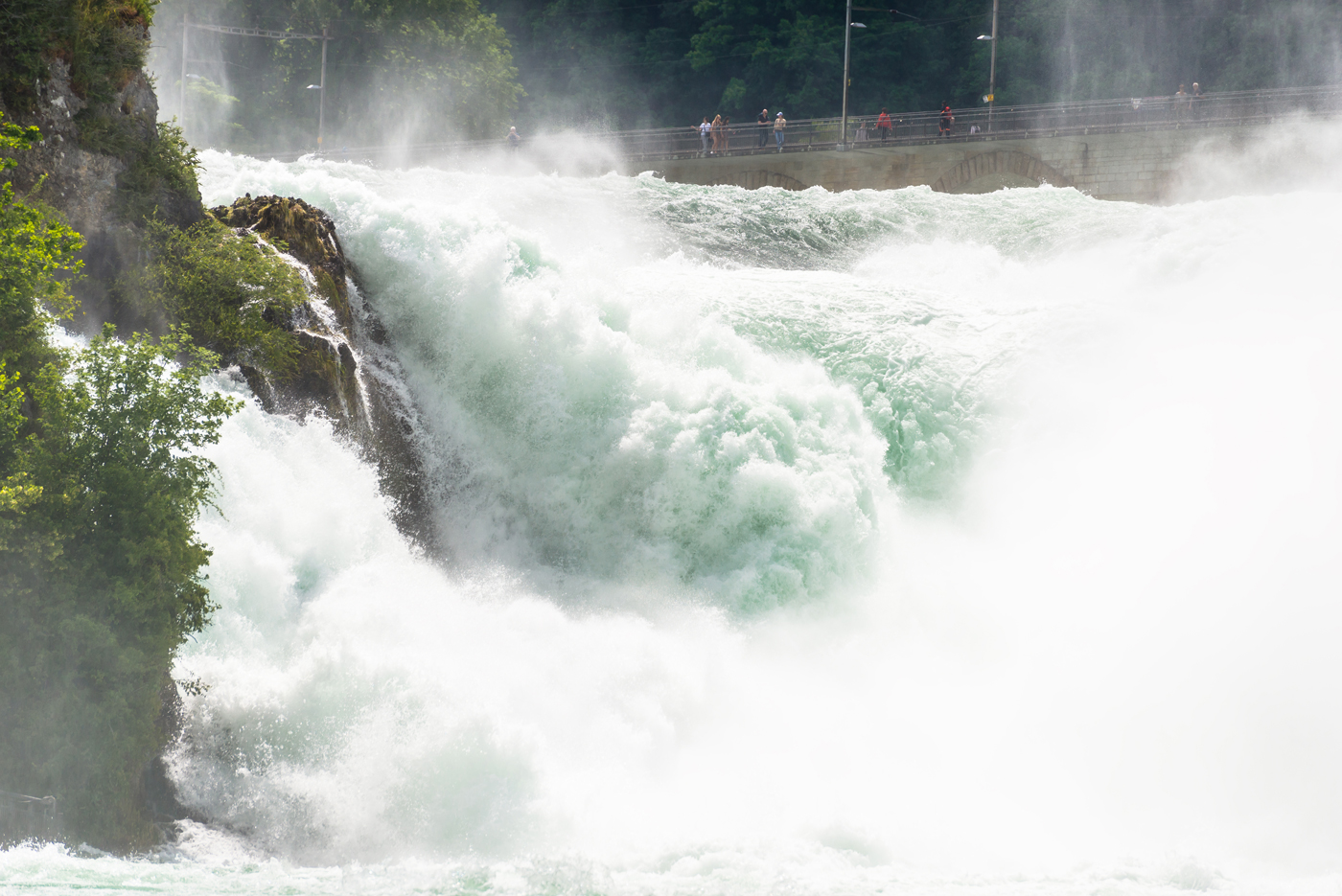
Rhine Falls. Photo @kinek00 via Twenty20
The average flow of the Rhine is 373 cubic metres of water per second (m³/s).
In summer, the flow is much higher due to the snow melting (remember: the Rhine has its source in the Swiss Alps): about 600 m³/s.
- The highest flow was measured in 1965 with 1250 m³/s.
- The lowest flow was recorded in 1921 with only 95 m³/s.
Comparison with other waterfalls
Our Swiss waterfalls belong among the three largest waterfalls in Europe together with :
Sarps Falls (or Sarpsfossen) in Norway. This waterfall has the same height but higher water flows with an average of 577 m³/s.
![Sarpsfossen © Thomas M. Hansen - licence [CC BY-SA 3.0] from Wikimedia Commons Sarpsfossen © Thomas M. Hansen - licence [CC BY-SA 3.0] from Wikimedia Commons](https://frenchmoments.eu/wp-content/uploads/2022/08/Sarpsfossen-©-Thomas-M.-Hansen-licence-CC-BY-SA-3.0-from-Wikimedia-Commons-scaled-1.jpg)
Sarpsfossen (Norway) © Thomas M. Hansen - licence [CC BY-SA 3.0] from Wikimedia Commons
Dettifoss waterfall in Iceland. The waterfall is twice as high (44 m) but with half the flow of the Swiss waterfalls.
![Dettifoss Islande © W. Bulach - licence [CC BY-SA 4.0] from Wikimedia Commons Les chutes de Dettifoss en Islande © W. Bulach - licence [CC BY-SA 4.0] from Wikimedia Commons](https://frenchmoments.eu/wp-content/uploads/2022/08/Dettifoss-Islande-©-W.-Bulach-licence-CC-BY-SA-4.0-from-Wikimedia-Commons.jpg)
Dettifoss falls in Iceland © W. Bulach - licence [CC BY-SA 4.0] from Wikimedia Commons
Of course, the comparison with Niagara Falls sends the Rhine Falls back to the land of the Lilliputians: 57 metres high and a flow rate of 2800 m³/s!
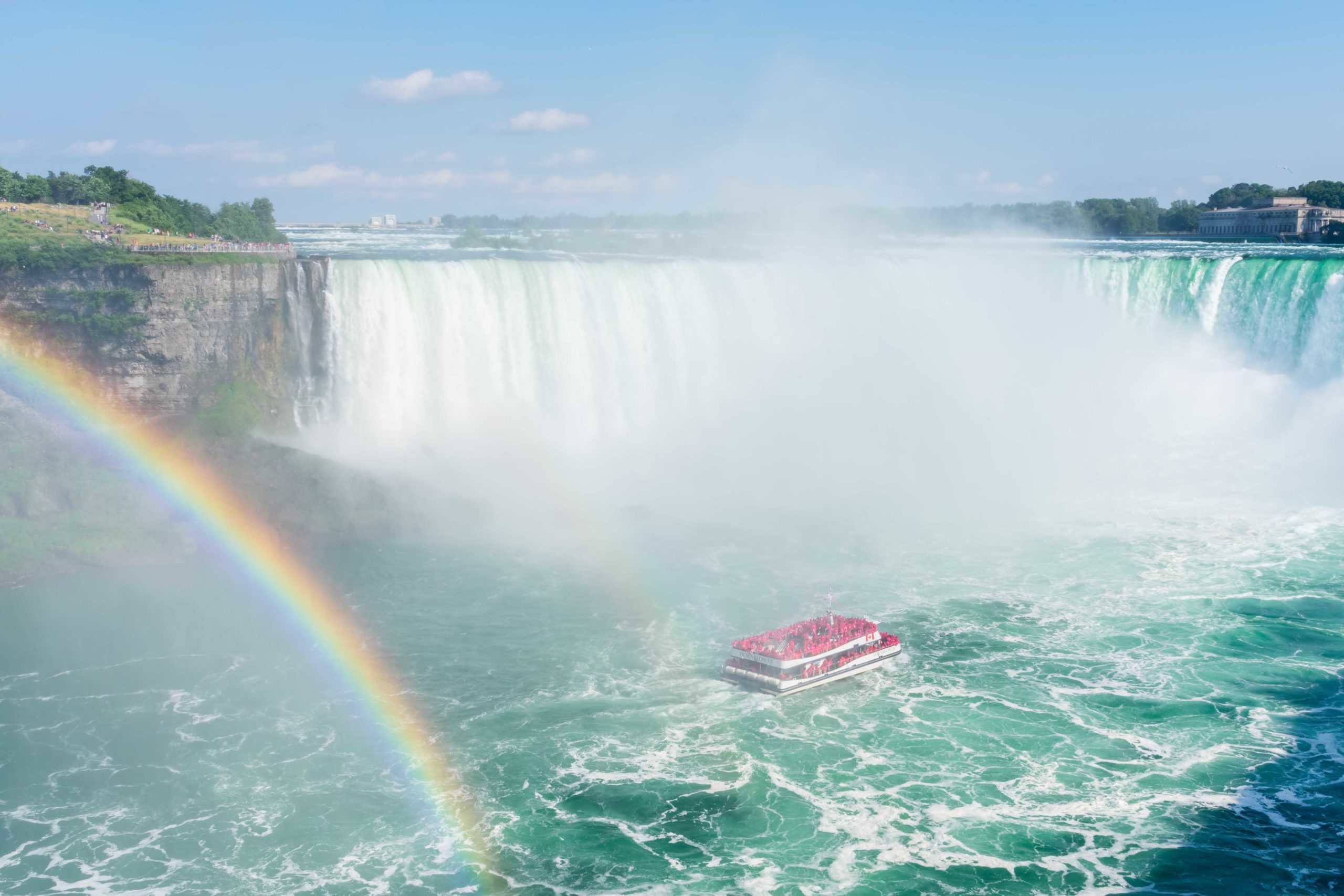
Niagara Falls. Photo: krisprahl via Envato Elements
A bit of linguistics!
You know that Switzerland is a country where four official languages are spoken. It is therefore not surprising that the toponymy of the Rhine Falls region differs from one language to another. Let's have a little vocabulary lesson now!
The Rhine Falls are called Rheinfall in German... and Rhyfall in Swiss German. They are called Cascate del Reno in Italian and Cascada dal Rain in Romansh. In French, they are called Chutes du Rhin.
Moreover, the Swiss (German-speaking) city of Schaffhausen is called Schaffhouse in French.
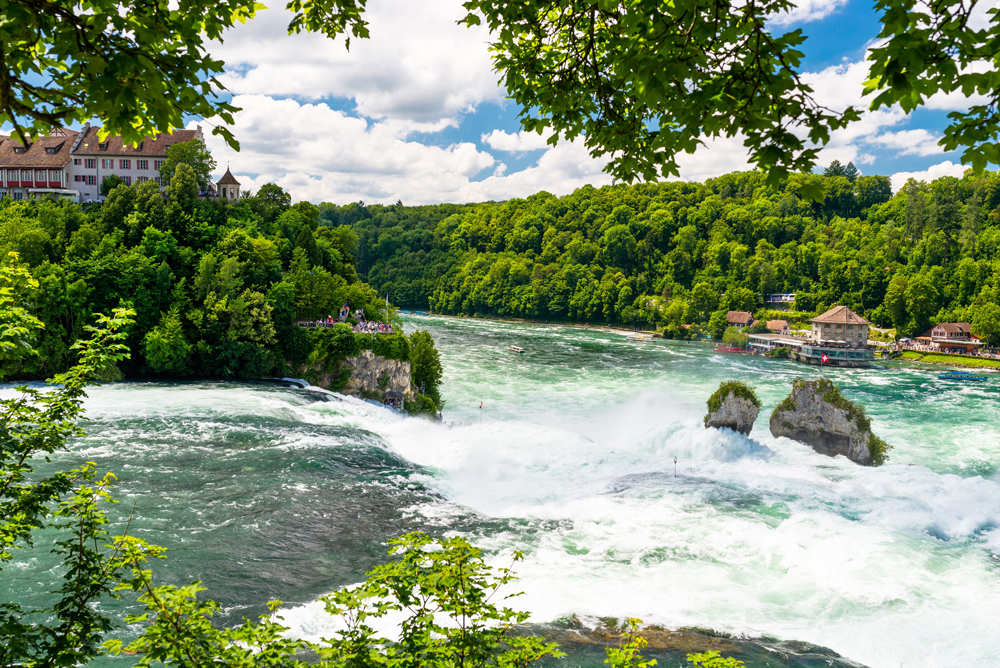
The falls. Photo @kinek00 via Twenty20
Several Rhine Falls!
Along its course from Lake Constance to Basel, the Rhine repeatedly comes up against resistant rocks that narrow the riverbed. The Rhine overcomes these by forming a waterfall (the Rhine Falls proper) and rapids. It is all a question of vocabulary, as we shall see..
Grosser and Kleinen Laufen... to complicate everything!
In the past, the locals referred to them as Grosser Laufen. "Laufen" is the German verb for running. In English, we have the word "course" (and "cours" in French) for the watercourse. In addition, we also use "rapids" ("des rapides" in French) to refer to the running of a river through rocks. Okay, are you still with me?
But then, if we have "Grosser Laufen", where are the "Kleinen Laufen" (small rapids)?
Well, hold on to your hat because... the small Rhine Falls no longer exist!
In fact, they were dynamited between 1908 and 1912 to improve the Rhine navigability and build a power station.
The Little Rhine Falls
These little Rhine Falls were located in Laufenburg, yes, the town of the rapids! Or should I say THE towns, because it comprises two villages separated by the Rhine: Laufenburg in Switzerland and Laufenburg in Germany.
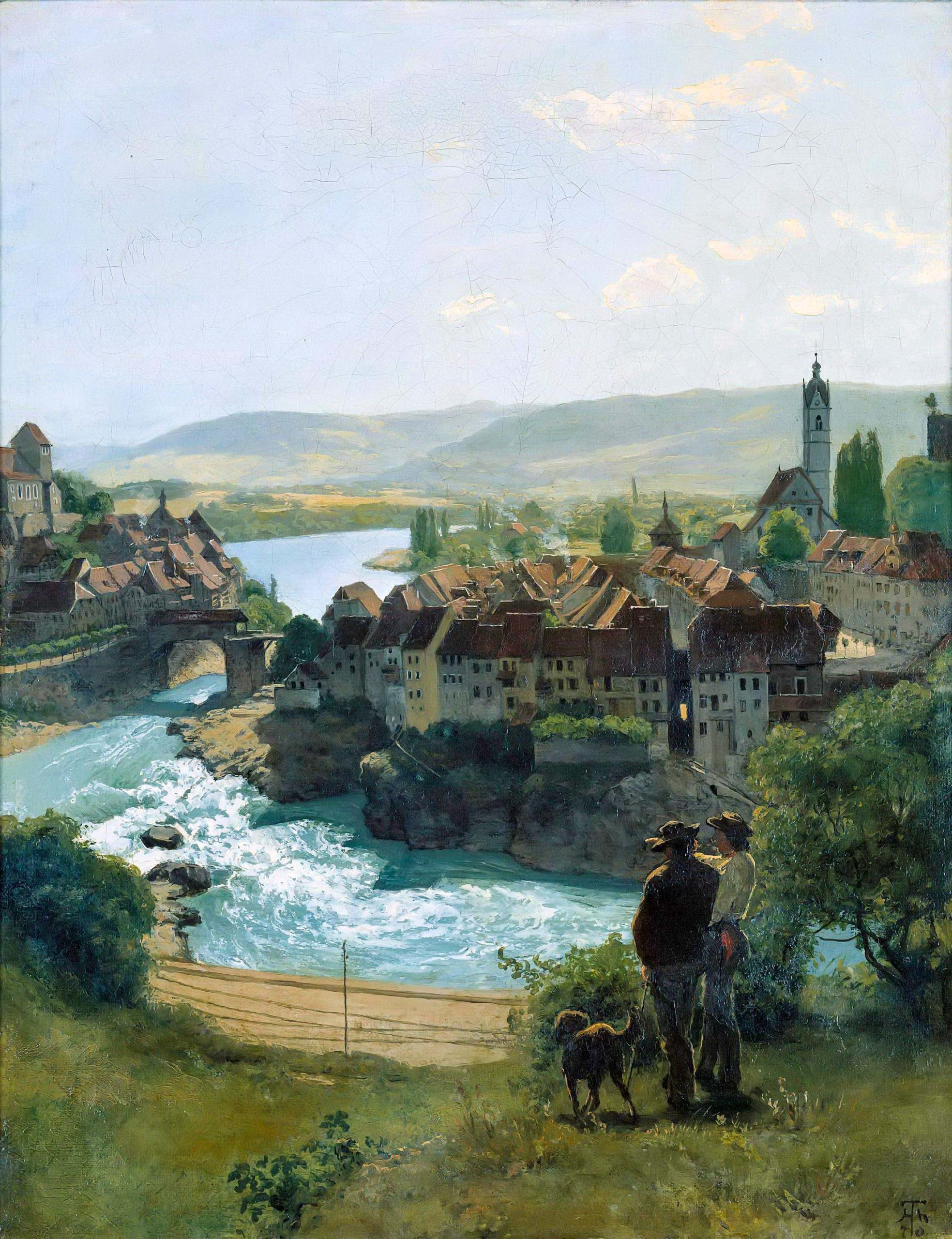
The Little Rhine Falls in Laufenburg - Painting: Hans Thoma 1870
Before their disappearance, the Laufenburg rapids were the most impressive waterfalls on the Upper Rhine after the (big) Neuhausen Rhine Falls.
![Laufenburg (Baden) © Taxiarchos228 - licence [CC BY 3.0] from Wikimedia Commons Laufenburg (Baden) © Taxiarchos228 - licence [CC BY 3.0] from Wikimedia Commons](https://frenchmoments.eu/wp-content/uploads/2022/08/Laufenburg-Baden-©-Taxiarchos228-licence-CC-BY-3.0-from-Wikimedia-Commons.jpg)
Today, the Rhine is gentle in Laufenburg (Germany)! © Taxiarchos228 - licence [CC BY 3.0] from Wikimedia Commons
The Middle Rhine Falls
If that wasn't complicated enough, we had to add the Middle Rhine Falls: the Mittlerer Lauffen.
Depending on which country you are in, they are called Ettikoner Laufen or Koblenzer Laufen. Because here, as in Laufenburg, the Rhine forms the border between Germany and Switzerland.

Rheinfall Mittlerer Lauffen by Merian 1654
Until the 1960s, the Mittlerer Lauffen and the Rhine Falls were the only rapids still intact on the Rhine between Schaffhausen and the Rhine estuary in the Netherlands.
![Koblenzer Laufen © Paebi - licence [CC BY-SA 4.0] from Wikimedia Commons Koblenzer Laufen © Paebi - licence [CC BY-SA 4.0] from Wikimedia Commons](https://frenchmoments.eu/wp-content/uploads/2022/08/Koblenzer-Laufen-©-Paebi-licence-CC-BY-SA-4.0-from-Wikimedia-Commons-scaled-1.jpg)
The Middle Rhine Falls near Koblenz © Paebi - licence [CC BY-SA 4.0] from Wikimedia Commons
The road to Marseille
The site was also used as a ford in ancient times. Supposedly, a pre-Roman trade route led from Massalia (= Marseille) to the Danube. It went up the Rhone to Lake Geneva and through the Swiss Mittelland before crossing the Rhine at Mittlerer Lauffen.
A bit of geological history
A long time ago, the general drop in temperature led to the first glacial advances on the Swiss plateau and shaped the present landscape.
Some believe that the Rhine once flowed westwards from Schaffhausen through the Klettgau. Then the river diverted its course southwards at Schaffhausen and westwards towards Basel.
In doing so, the Rhine formed a wide arc at the site of the falls. The rocks of the Rhine Falls are the remains of the initially steep limestone flank of the former flow channel.
![Rheinfall Schaffhausen © Sven Scharr - licence [CC BY 3.0] from Wikimedia Commons Rheinfall Schaffhausen © Sven Scharr - licence [CC BY 3.0] from Wikimedia Commons](https://frenchmoments.eu/wp-content/uploads/2022/08/Rheinfall-Schaffhausen-©-Sven-Scharr-licence-CC-BY-3.0-from-Wikimedia-Commons-scaled-1.jpg)
Schaffhausen's Rheinfall from above © Sven Scharr - licence [CC BY 3.0] from Wikimedia Commons
A bit of economic history
As early as the 11th century, a small mill was operated on the left bank of the Rhine Falls. Later on, milling and blacksmith shops were established here. From the early 19th century, two dams just above the falls supplied water to the waterwheels of the forge and the mill via the canal inlets.
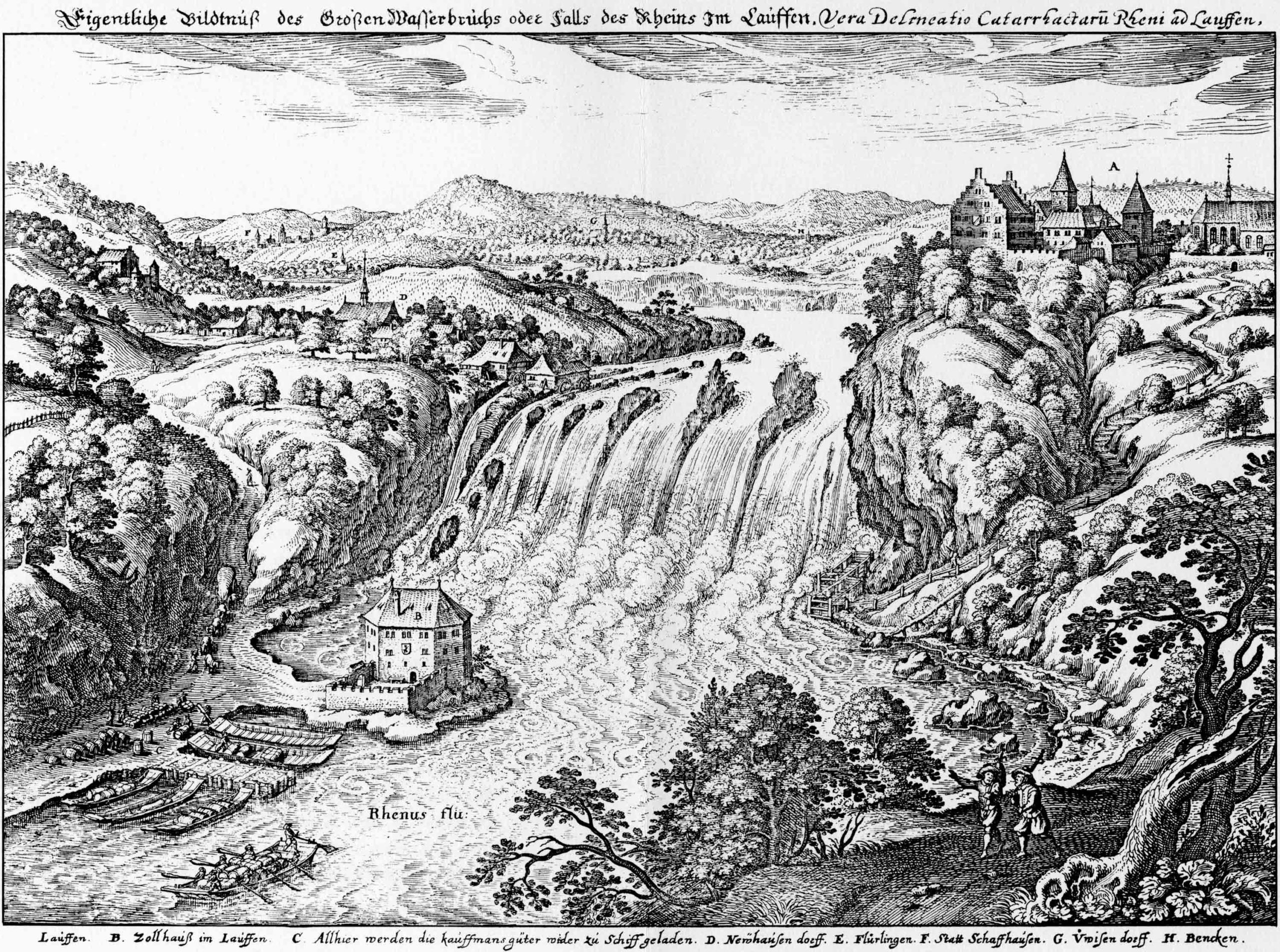
Depiction of the Rhine Falls in 1642 by Merian
Foundry, wagons and aluminium
In the 16th century, a smelter worked the iron ore here. This closed at the end of the 18th century. In 1810, Johann Georg Neher took over the old forge and turned it into the first significant ironworks in the region.
In 1853, the "Schweizerische Waggons-Fabrik" (later called SIG) was founded. The company used hydroelectric power to operate. This was also the case for the Aluminium-Industrie-Actien-Gesellschaft Neuhausen (founded in 1888). Aluminium production ceased in 1945.
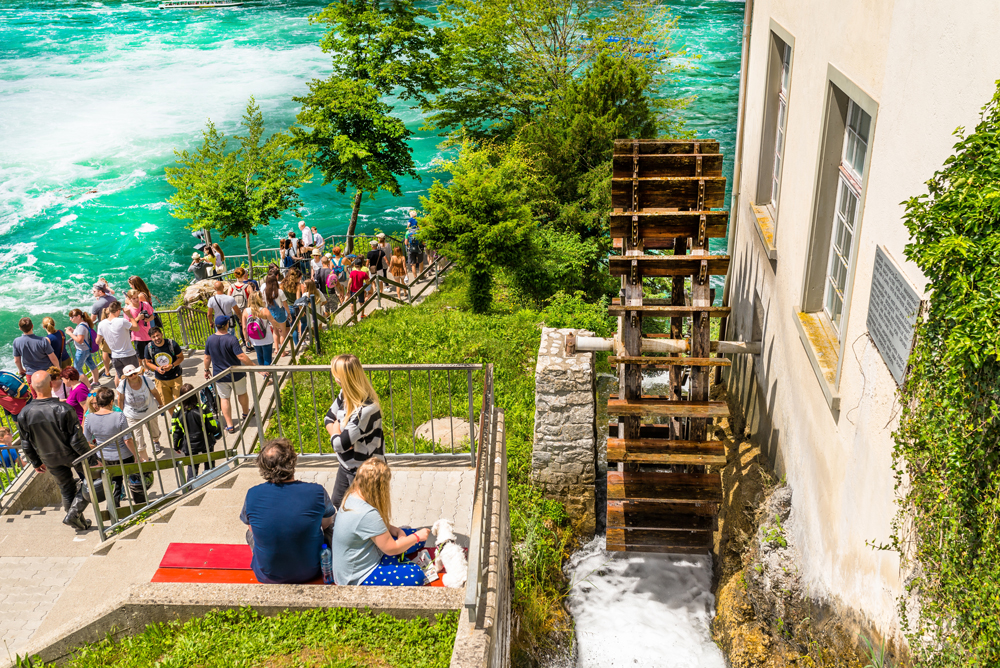
The watermill. Photo @kinek00 via Twenty20
Projects and water power
Towards the late 19th and early 20th centuries, the authorities began considering the technical use of the Rhine Falls. Projects were proposed to construct the Rhine Falls for navigation, but these were not carried out.
The falls were (and still are) an obstacle to navigation between Lake Constance and Basel. In the early 1960s, plans were made to build a waterway around the Rhine Falls with a 552-metre-long tunnel and a lock behind Laufen Castle. The project failed...
The water power of the falls is still used to generate energy today, for example, in the Neuhausen power station with its 4.4 MW.
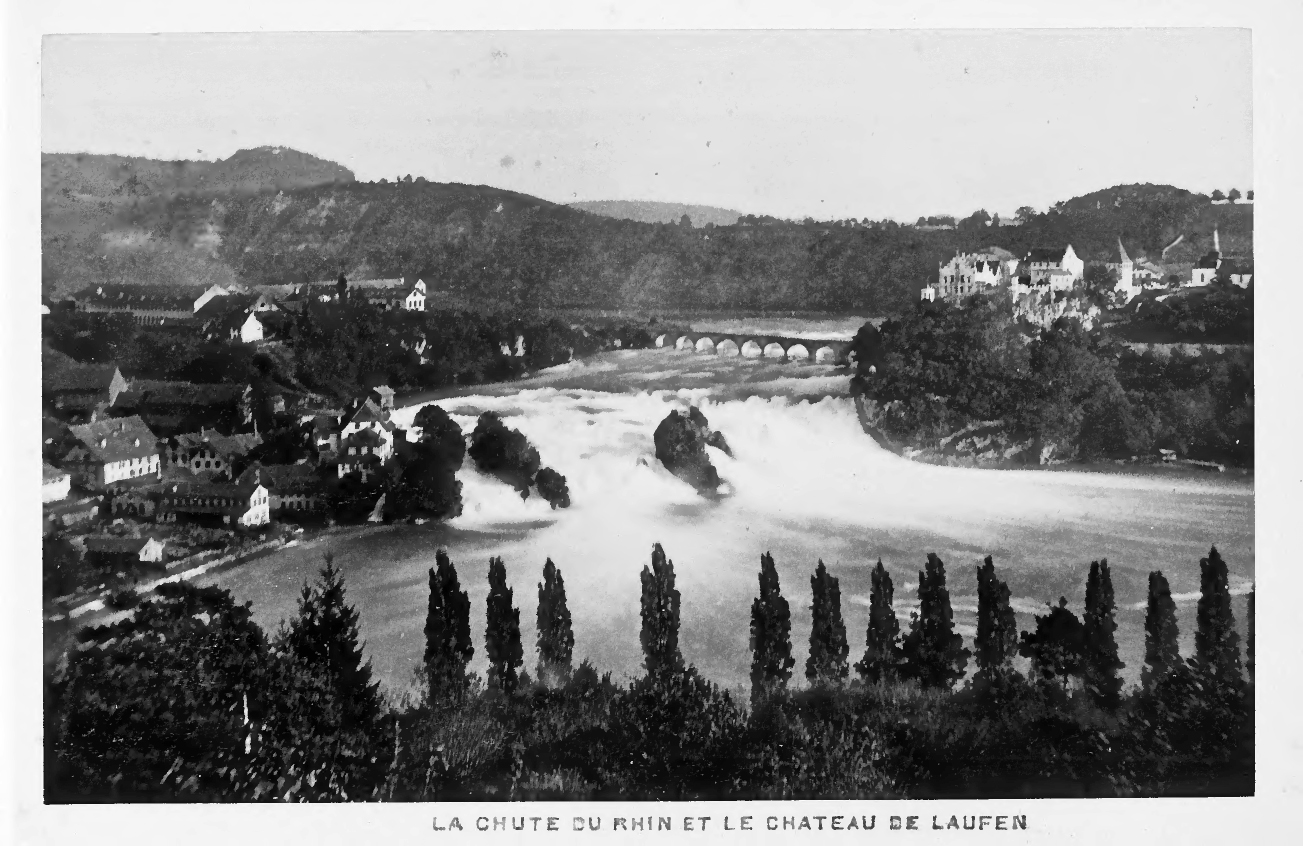
Postcard of the Schaffhausen Falls (ca. 1880)
And then the railway came along...
The connection of the Rhine Falls region to the railway network in the second half of the 19th century led to a boom in the local hotel industry.
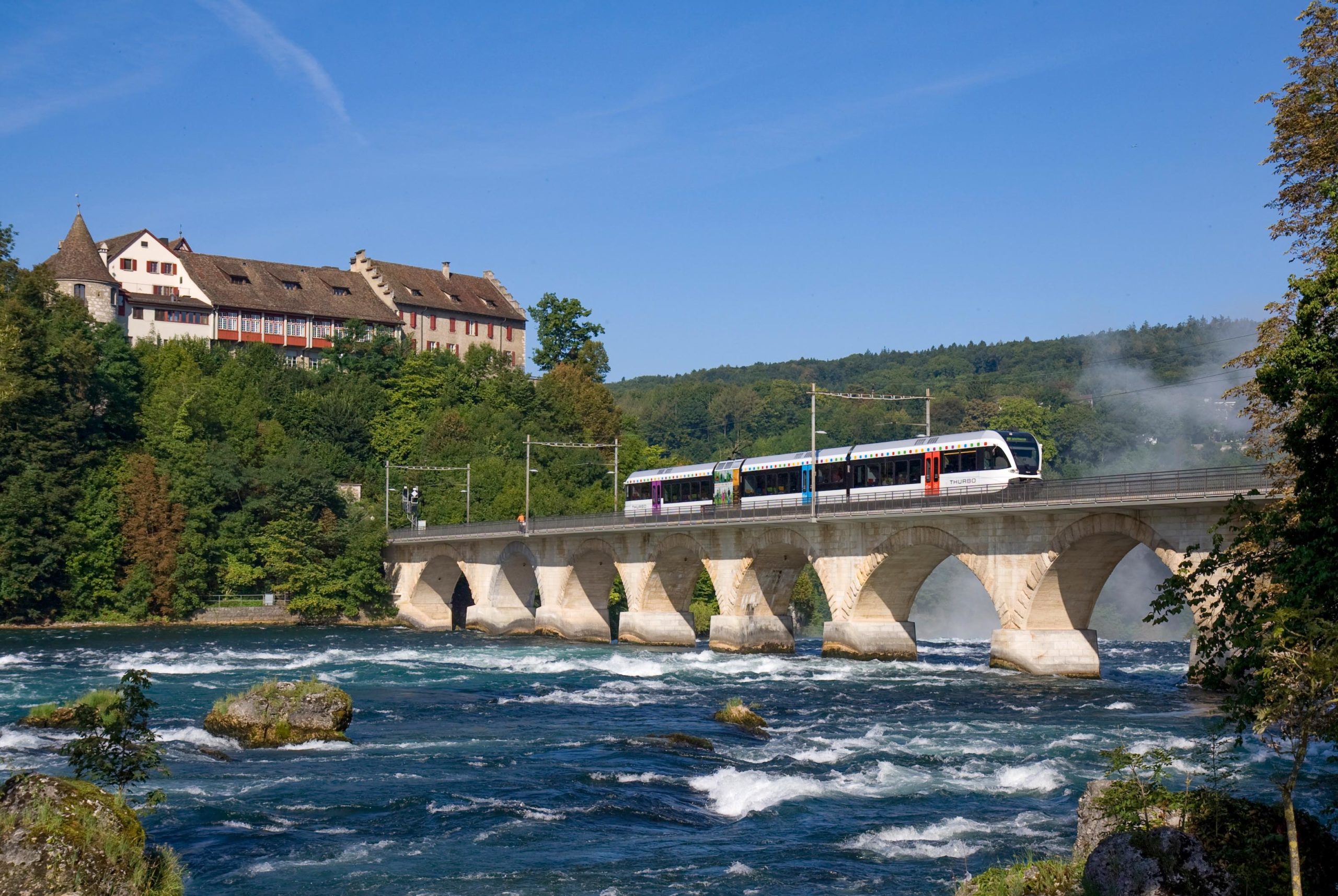
The Rhine bridge in Laufen © David Gubler - Creative Commons Attribution NonCommercial ShareAlike 2.5
But the hotel business in Neuhausen declined from the beginning of the 20th century. The culprits were threefold:
- the development of tourist centres in the Swiss mountains,
- the development of Neuhausen as an industrial area,
- the change in the behaviour of travellers.
Find out more about the history of human activity at the Rhine Falls...
Visiting the Rhin Falls
It is estimated that more than 1,300,000 people visit the Falls every year... making them a major tourist attraction in the Upper Rhine region.
The success of the Rhine Falls is mainly due to its location. Indeed, they have the particularity of being located in a charming setting that could be the envy of Niagara Falls!
Castles, rocks, Swiss flag... the site is as picturesque as one could wish with its Old Europe airs! (that's a compliment 😉 )
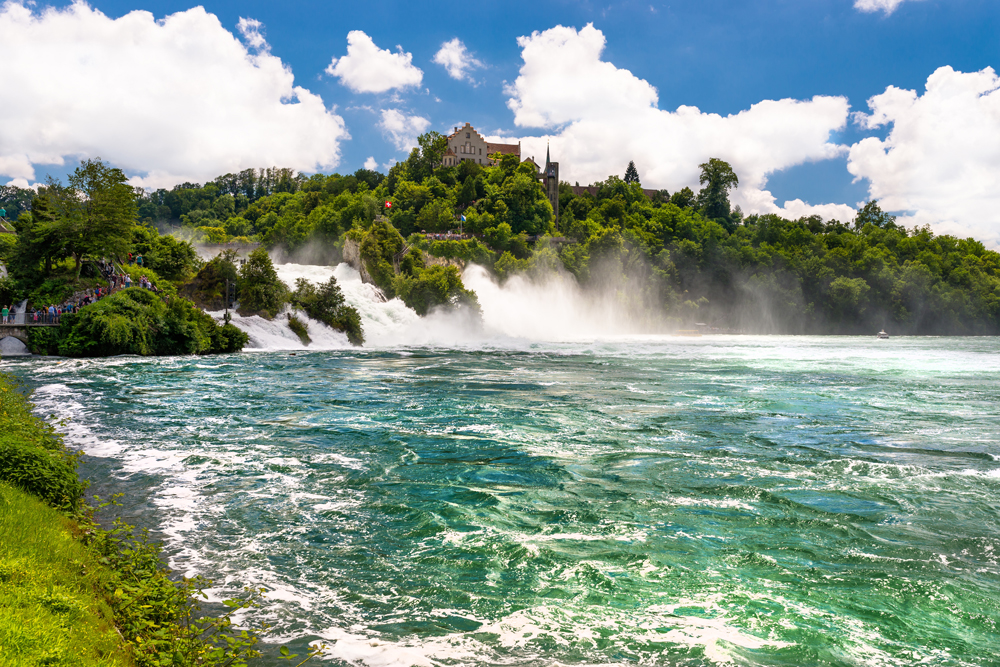
The Rhine Falls. Photo @kinek00 via Twenty20
Follow the paths
Landscaped paths take you to view platforms on both sides of the Rhine. These sometimes rise high above the river.
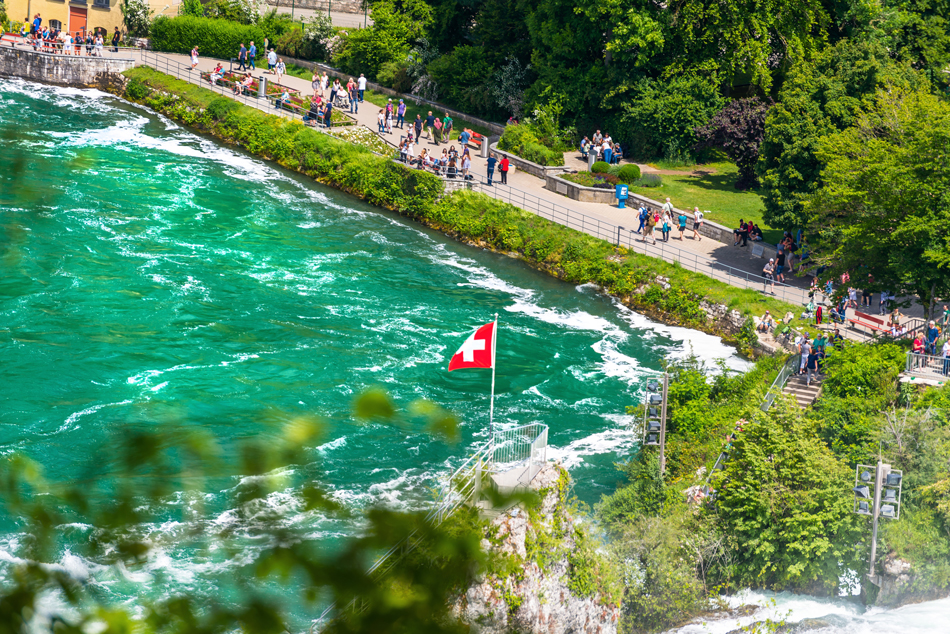
One of the paths. Photo @kinek00 via Twenty20
Take a boat ride to the central rock
Schlössli Wörth (Wörth Castle) is located on the right bank below the falls in Neuhausen am Rheinfall.

Wörth Castle as a starting point for Rhine cruises. Photo @kinek00 via Twenty20
From here, tour boats take you as close as possible to the Rhine Falls and drop you off at the central rock.
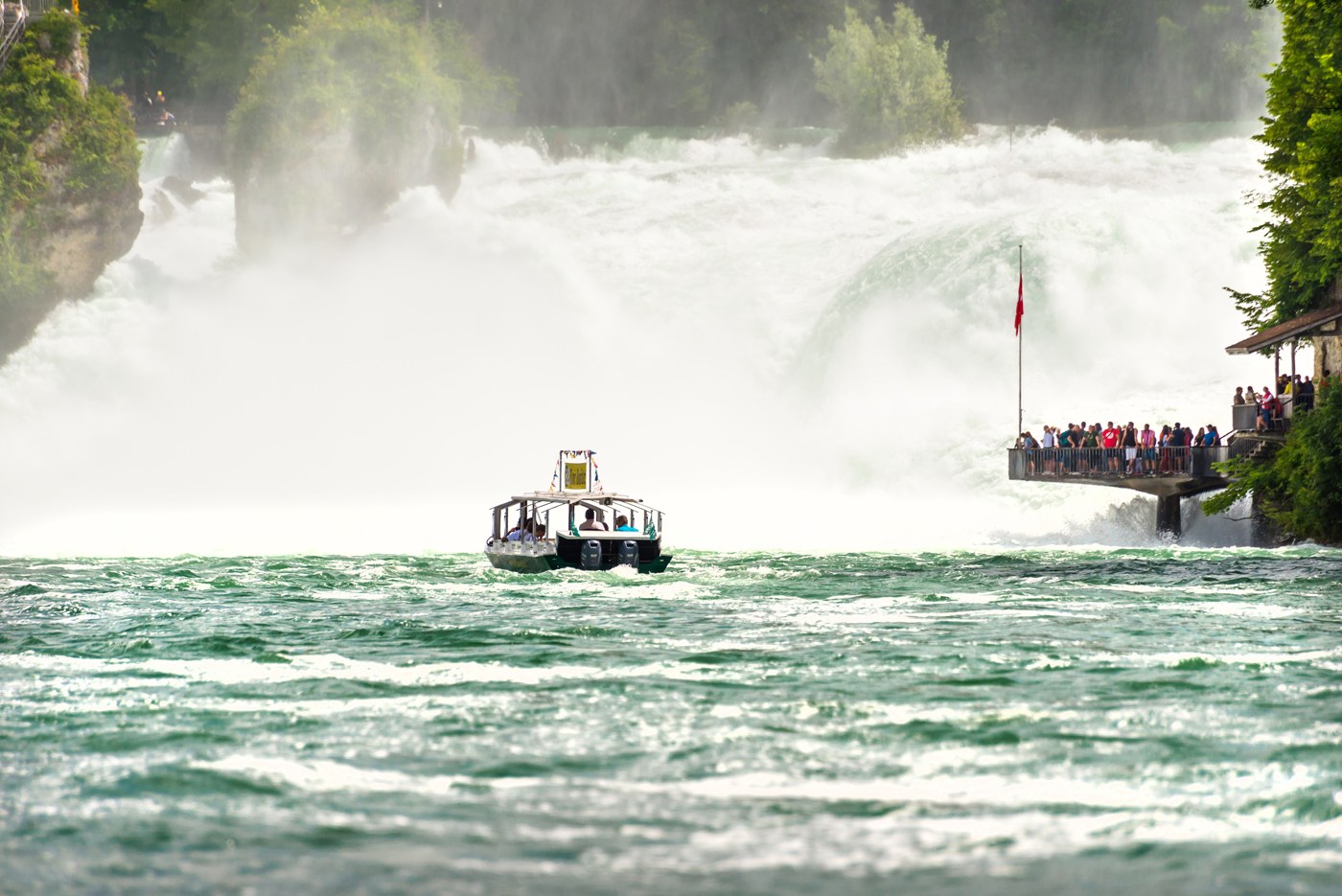
The boat heads for the central rock. Photo @kinek00 via Twenty20
The observation platform offers a close-up view of the falls, and access is via steep, narrow stairs.
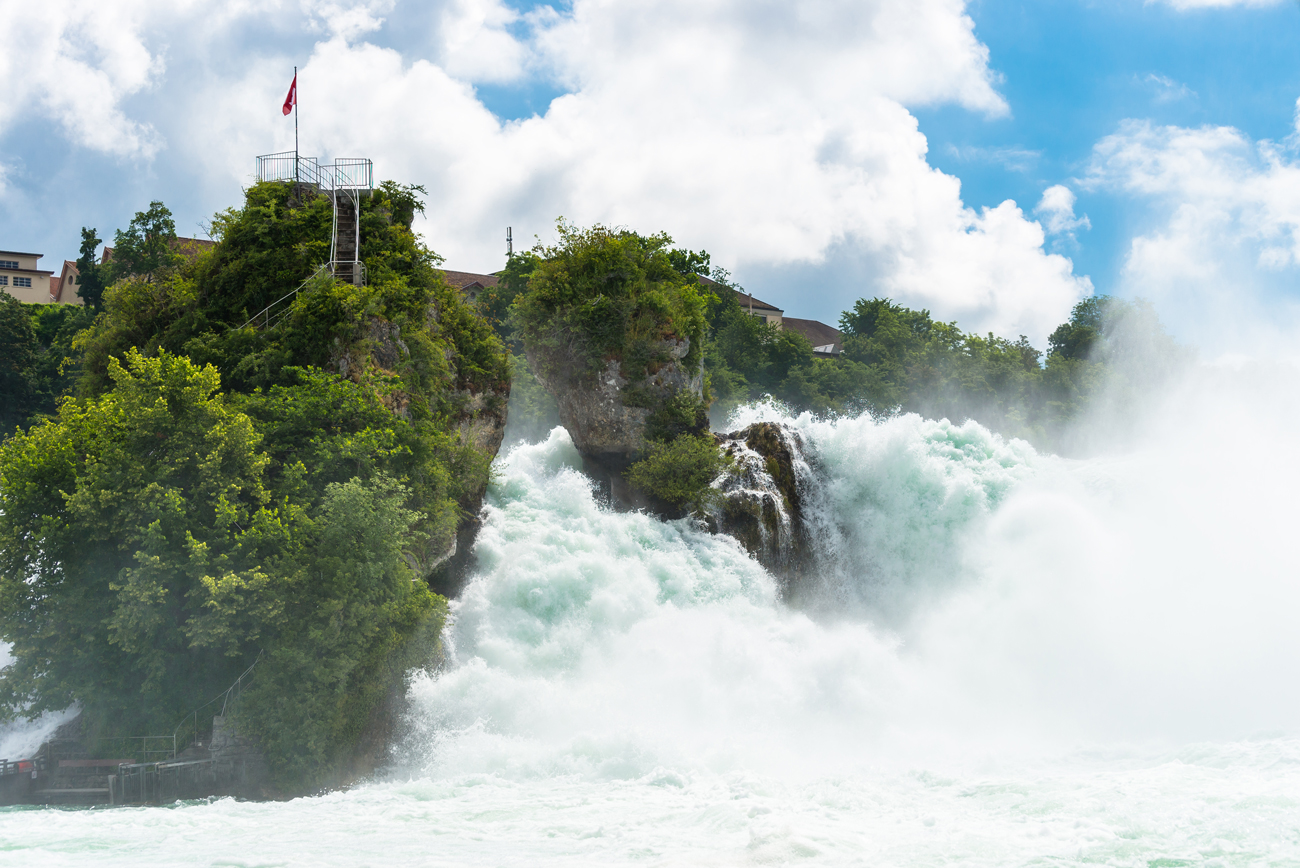
The central rock. Photo @kinek00 via Twenty20
Reach Laufen Castle
In addition, there are short and long tours of the Rhine Falls, as well as the crossing to Schloss Laufen (Laufen Castle), which overlooks the falls on the left bank (Canton Zurich).
![Schloss Laufen © Roland zh - licence [CC BY-SA 3.0] from Wikimedia Commons Schloss Laufen © Roland zh - licence [CC BY-SA 3.0] from Wikimedia Commons](https://frenchmoments.eu/wp-content/uploads/2022/08/Schloss-Laufen-©-Roland-zh-licence-CC-BY-SA-3.0-from-Wikimedia-Commons-scaled-1.jpg)
Schloss Laufen © Roland zh - licence [CC BY-SA 3.0] from Wikimedia Commons
The first documented mention of Laufen Castle dates back to the year 858. The fortress was the ancestral seat of the Barons of Laufen. In 1544, the city of Zurich acquired the castle, which underwent major structural changes between 1544 and 1547. Since 1941 it has belonged to the canton of Zurich.
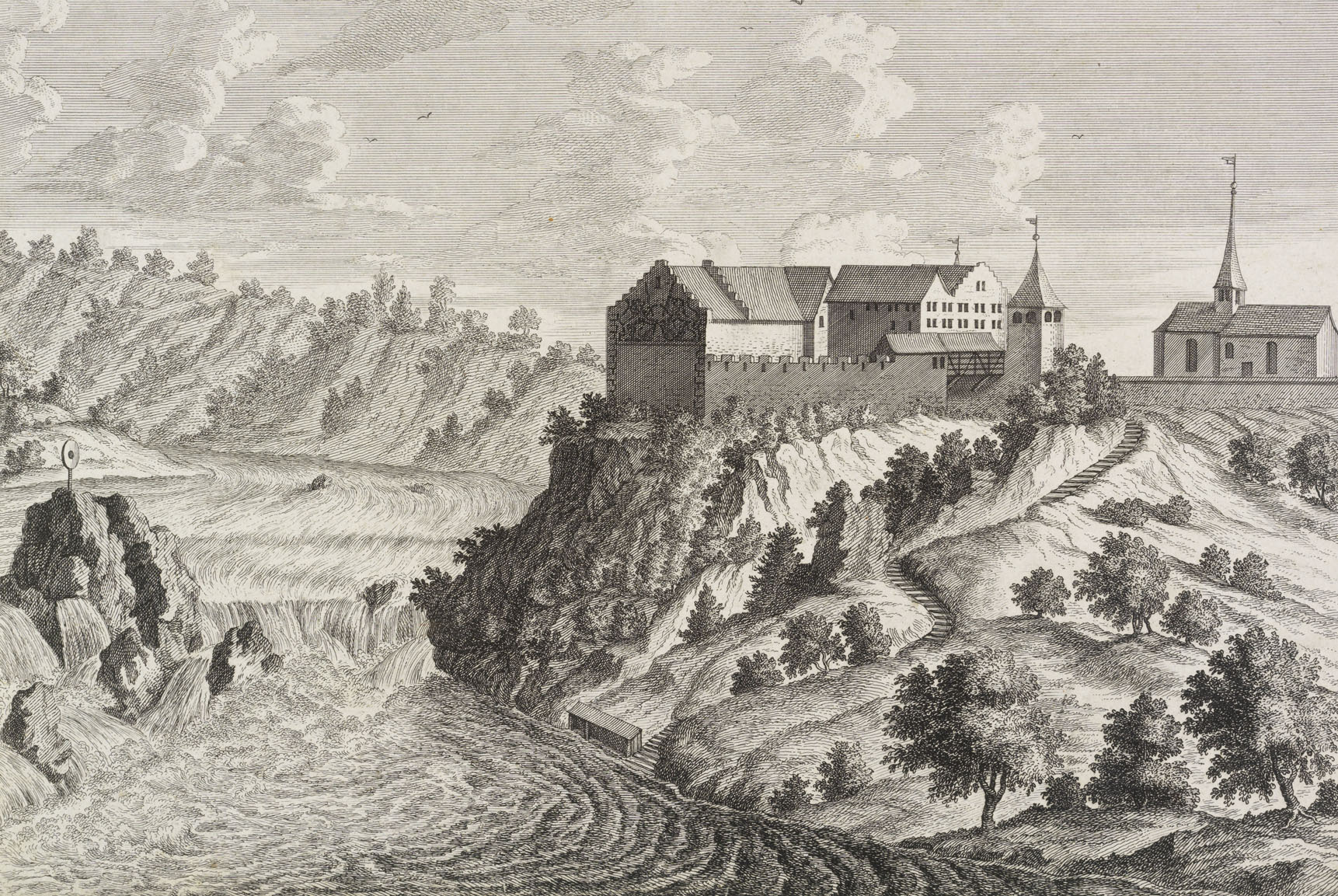
Laufen Castle. Engraving of David Herrliberger (circa 1750)
Get close to the water
In 2008, the paths around the castle were renovated, and a glass lift was installed. Some parts of the tracks have been made chargeable, including the discovery path (Erlebnispfad) leading to the observation platforms.
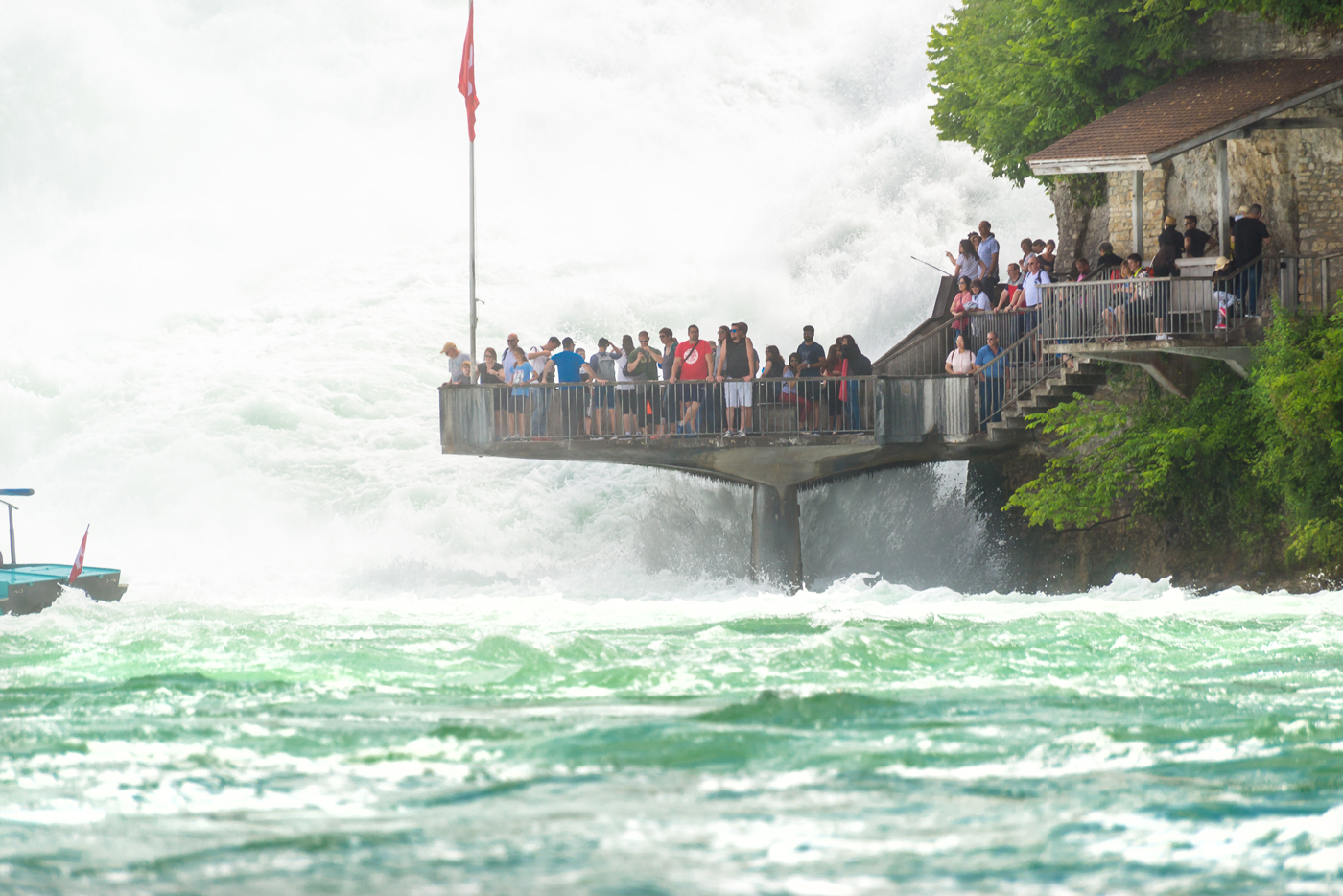
The observation platform close to the waterfalls. Photo @kinek00 via Twenty20
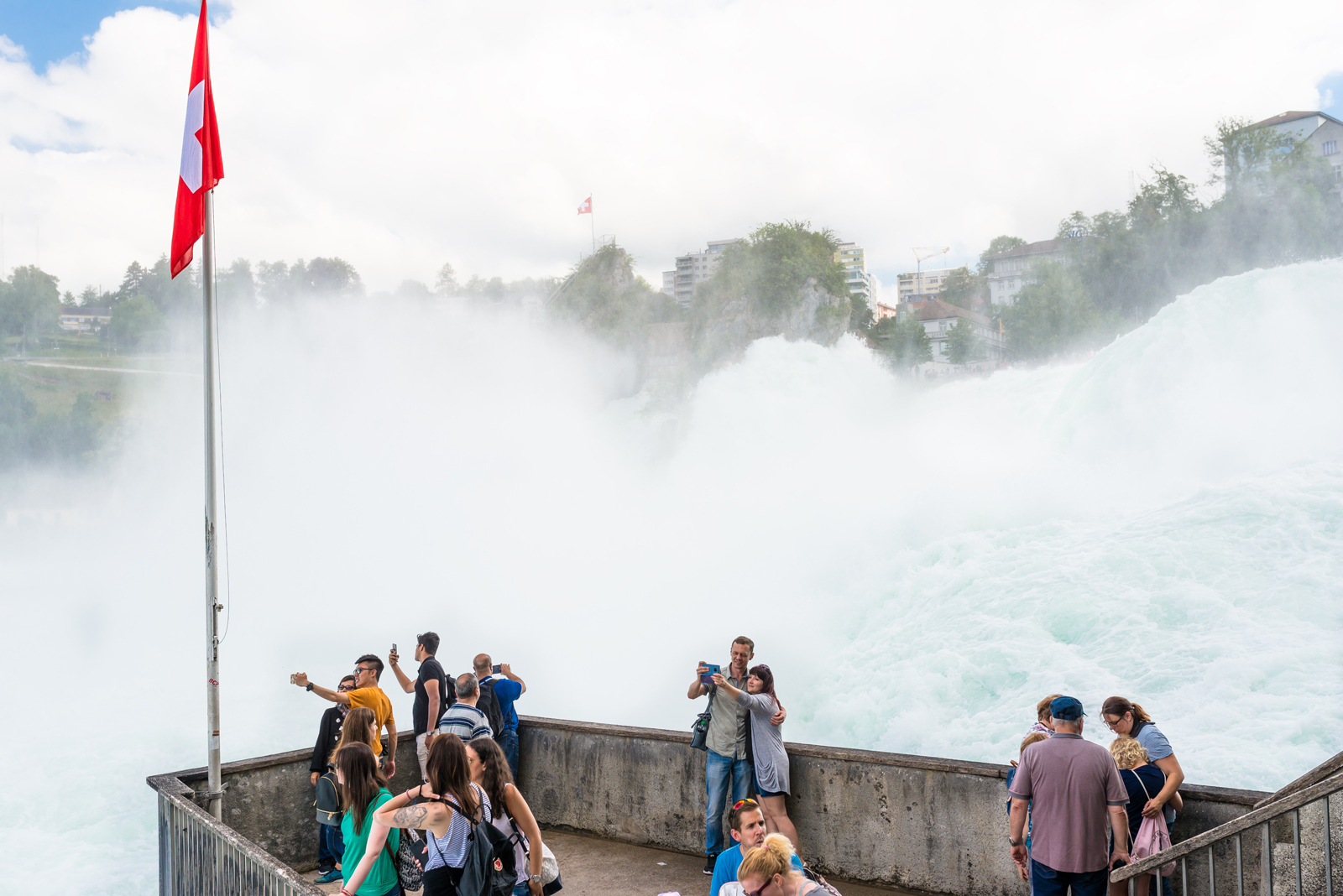
The tumult of the Rhine Falls. Photo @kinek00 via Twenty20

Close to the waterfalls. Photo @kinek00 via Twenty20

On the observation platform. Photo @kinek00 via Twenty20
Practical Tips for Visiting the Rhine Falls
Here are some tips for visiting the falls and some good advice on making your visit to the falls unforgettable!
Before your visit, I advise you to get to know the site. You can download the site map (PDF)
The map above gives you information on the location of car parks, restaurants, public toilets and other tourist sites.
Cruises and crossings
For more information on the various cruises and crossings, visit the Rhyfall Mändli website. Please note: you must book in advance!
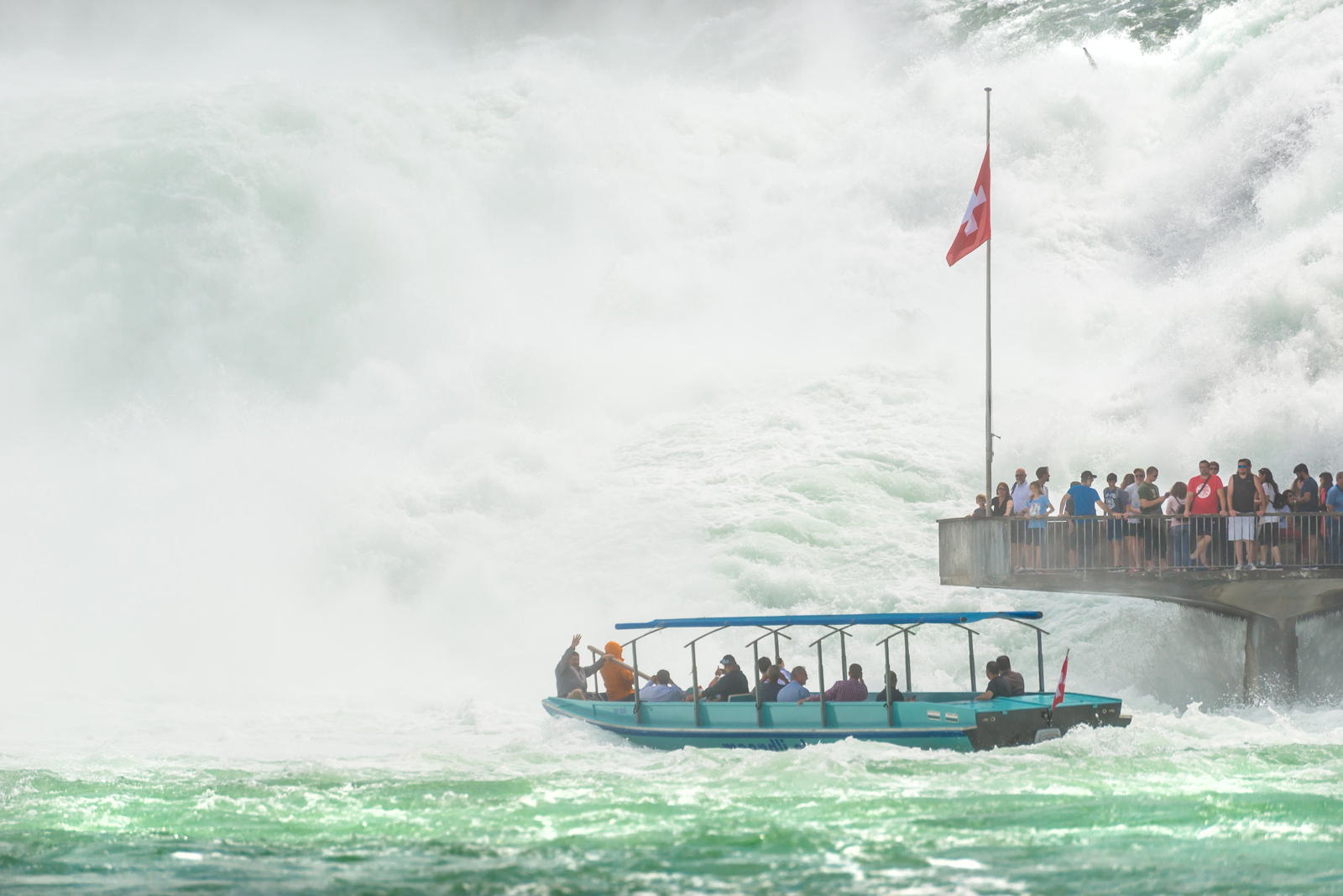
Cruise on the Rhine Falls. Photo @kinek00 via Twenty20
Yellow Line (n° 1): Down the cliff
This is the cruise you must take if you want to climb the central rock! Duration: 30 minutes
Red Line (n° 2): Crossing of the Rhine
The pedestrian ferry is ideal for crossing to the other side of the river from the left bank (Laufen Castle) or the right bank (Wörth Castle). Duration: 5 minutes
Blue Line (n° 4): Little Tour
This fascinating tour of the Rhine Falls takes you as close as possible to the tumultuous waterfalls! Duration: 15 minutes
Pink Line (n° 5): Big Tour
The pink line follows the route of the blue line but ventures downstream on the Rhine. This audio guide tour (French available) will allow you to learn more about the tourist site. Duration: 30 minutes
Schiffmändli cruises
Schiffmändli offers longer cruises down the Rhine from Wörth Castle to Rheinau. You have the option of walking back to the falls. More information.
Eating out on site
There are several restaurants and food stalls on site. There is something for all tastes and budgets (well, on this last point, let's put it into perspective because we are still in Switzerland 😉 )
All the restaurant sites are on this link!
Staying in the Schaffhausen region
If you want to stay one or more nights in the region, you will find a wide choice of accommodation in Schaffhausen.
Good to know: Hotel room prices are generally lower on the German side.
Check out the list of accommodations by clicking here or browse the map below:
The Rhine Falls by night!
If you are staying overnight in the region, you should know that the Rhine Falls are regularly illuminated at night, but not all year round... You can find out more on the falls website by consulting the annual programme of illuminations.
![Rheinfall by Night © Tremendous-Photography - licence [CC BY-SA 3.0] from Wikimedia Commons Rheinfall by Night © Tremendous-Photography - licence [CC BY-SA 3.0] from Wikimedia Commons](https://frenchmoments.eu/wp-content/uploads/2023/05/Rheinfall-by-Night-©-Tremendous-Photography-licence-CC-BY-SA-3.0-from-Wikimedia-Commons-scaled.jpg)
Rheinfall by Night © Tremendous-Photography - licence [CC BY-SA 3.0] from Wikimedia Commons
On 31 July, the falls are the setting for a magnificent spectacle of lights and fireworks: "Fire on the Rocks".
![Rheinfall Fireworks © SISHION - licence [CC BY-SA 4.0] from Wikimedia Commons Rheinfall Fireworks © SISHION - licence [CC BY-SA 4.0] from Wikimedia Commons](https://frenchmoments.eu/wp-content/uploads/2023/05/Rheinfall-Fireworks-©-SISHION-licence-CC-BY-SA-4.0-from-Wikimedia-Commons-scaled.jpg)
Rheinfall Fireworks © SISHION - licence [CC BY-SA 4.0] from Wikimedia Commons
Adventure Park Rheinfall
The Adventure Park Rheinfall, located above Wörth Castle, offers a magnificent view of the Rhine Falls. Children from four years of age can playfully navigate the 170 obstacles in the trees. More information.
![Seilpark Rheinfall © Klaus wyss - licence [CC BY-SA 3.0] from Wikimedia Commons The Rheinfall Adventure Park © Klaus wyss - licence [CC BY-SA 3.0] from Wikimedia Commons](https://frenchmoments.eu/wp-content/uploads/2023/05/Seilpark-Rheinfall-©-Klaus-wyss-licence-CC-BY-SA-3.0-from-Wikimedia-Commons.jpg)
The Rheinfall Adventure Park © Klaus wyss - licence [CC BY-SA 3.0] from Wikimedia Commons
The Swiss Miniature World
Visit Smilestones, Switzerland's largest miniature world, near Neuhausen Rheinfall station. You will discover on display the Rhine Falls and other Swiss sights and landscapes on a 1:87 scale (H0 scale). Further information.
![Smilestones Rheinfall © Anhihe - licence [CC BY-SA 4.0] from Wikimedia Commons The Rheinfall at Smilestones © Anhihe - licence [CC BY-SA 4.0] from Wikimedia Commons](https://frenchmoments.eu/wp-content/uploads/2023/05/Smilestones-Rheinfall-©-Anhihe-licence-CC-BY-SA-4.0-from-Wikimedia-Commons-scaled.jpg)
The Rheinfall at Smilestones © Anhihe - licence [CC BY-SA 4.0] from Wikimedia Commons
The Rhine Falls in art
The Flemish painter Joachim Patinier first depicted the Rhine Falls in his painting Taufe Christi (1515-1520). The author transposed the scene of Christ's baptism in the Jordan to the Upper Rhine.

Joachim Patinier - The baptism of Christ
In 1544, Sebastian Münster produced a woodcut of the Rhine Falls in his Cosmographia Universalis. This is the first graphic presentation of the Rhine Falls in context.
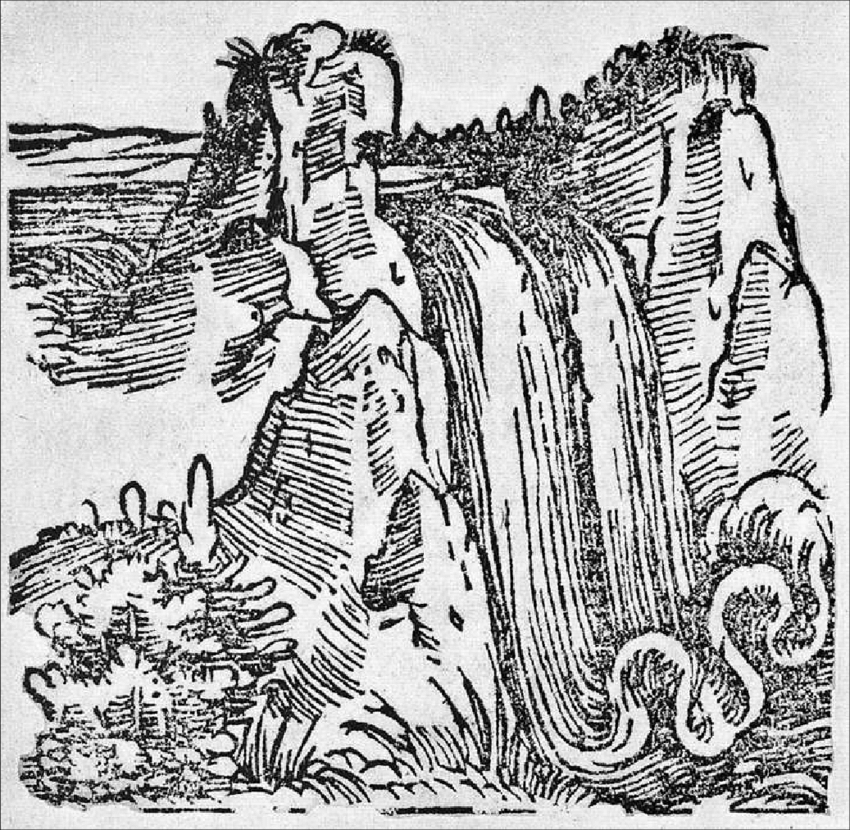
The falls by Sebastian Münster (1544)
However, the most critical depiction is undoubtedly that by William Turner. The painting is now on display at the Museum of Fine Arts in Boston.

William Turner Fall of the Rhine at Schaffhausen
The Swiss painter Louis Bleuler painted the falls around 1850. His painting is in the Rosgartenmuseum in Constance.
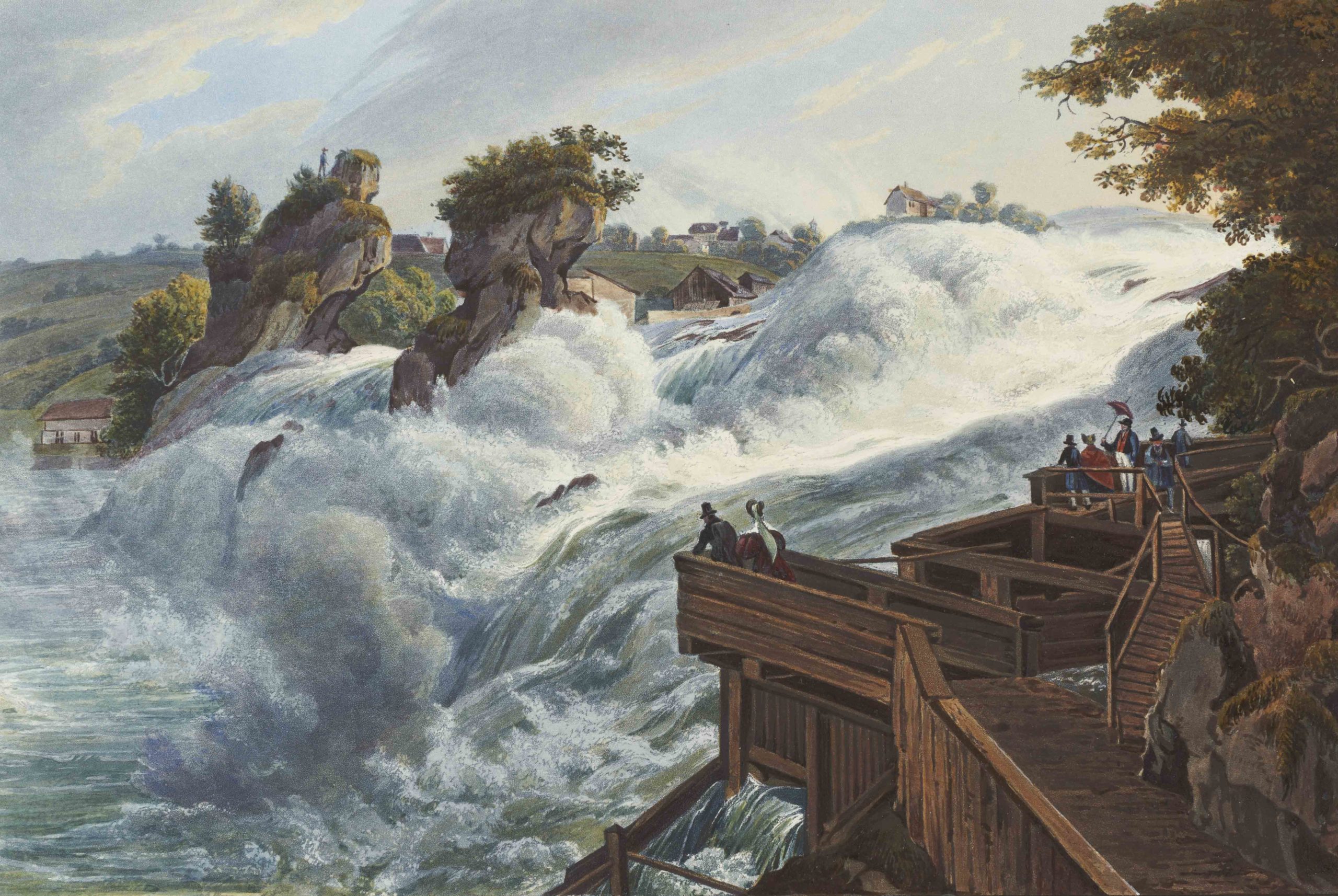
Vue de la rive gauche (1836) - Johann Ludwig Bleuler
Other paintings and sketchings depicting the Rheinfall of Schaffhausen:
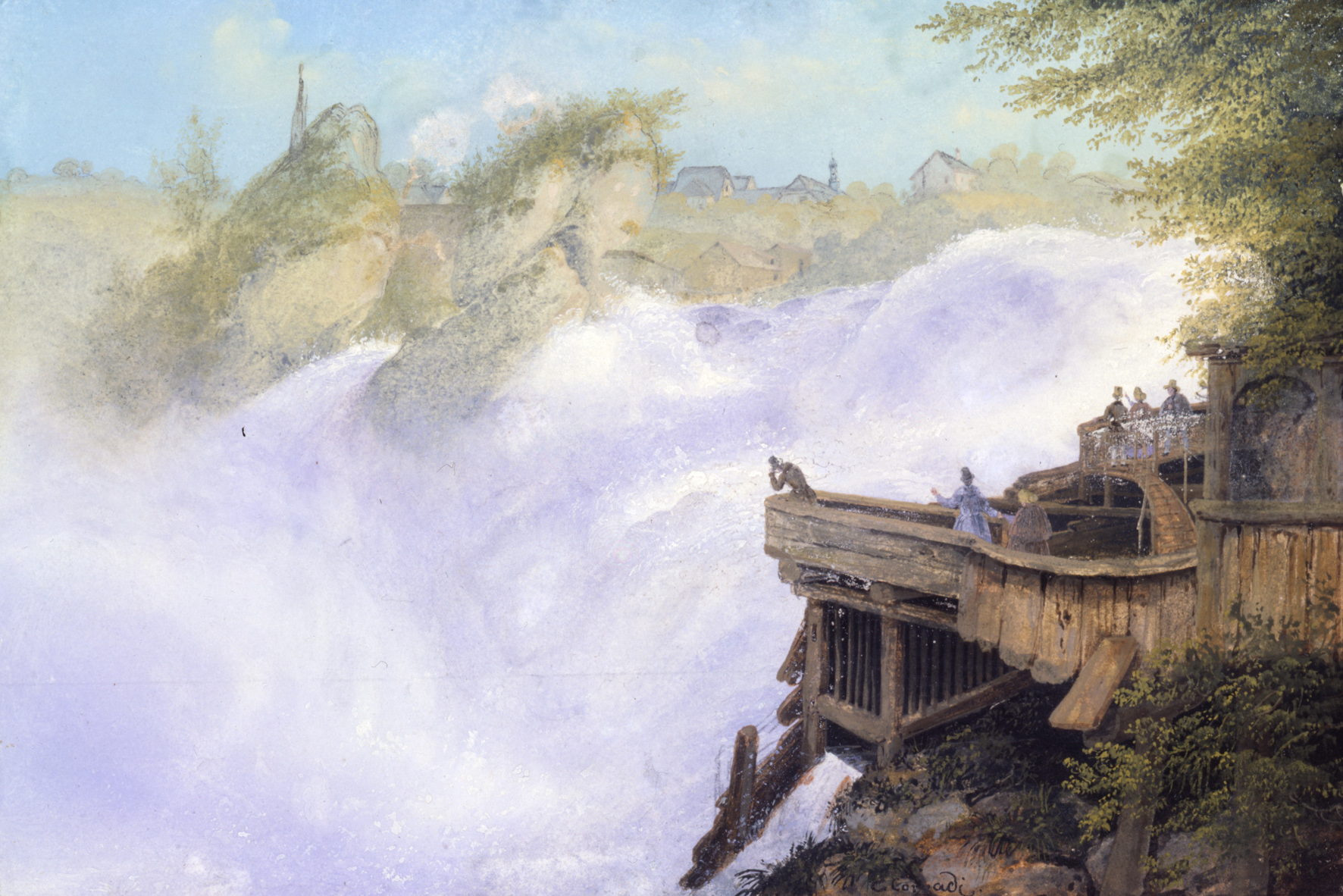
Painting by Konrad Corradi (1860)

Painting by Philip James de Loutherbourg (1788)
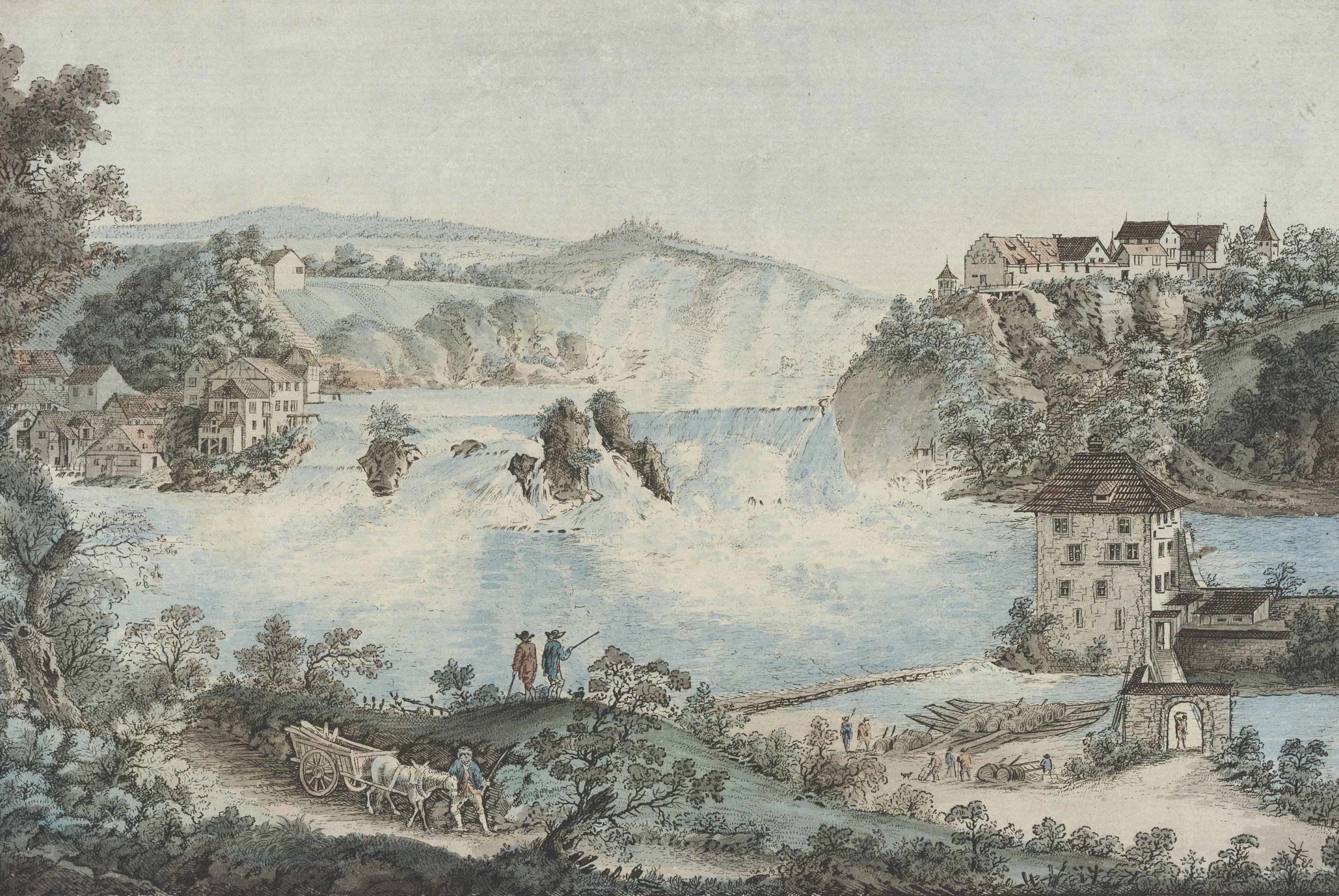
Johann Jakob Aschmann - Engraving circa 1784

Heinrich Müller - les Chutes du Rhin avec usines et pont de chemin de fer (vers 1870)

Painting by Arnold Jenny
Two final anecdotes
To conclude this article, here are two interesting anecdotes about the Rhine Falls.
They shall not pass!
The Rhine Falls are not only an obstacle to navigation between Lake Constance and Basel. They are also impassable to fish upstream. Except for the eel. Eels are so clever that they sneak up the sides (outside the riverbed, on land) to get up the rocks.
![The central rock © uploaded with Commonist and work of Hansueli Krapf - licence [CC BY-SA 4.0] from Wikimedia Commons The central rock © uploaded with Commonist and work of Hansueli Krapf - licence [CC BY-SA 4.0] from Wikimedia Commons](https://frenchmoments.eu/wp-content/uploads/2023/05/Rheinfall-©-uploaded-with-Commonist-and-work-of-Hansueli-Krapf-licence-CC-BY-SA-4.0-from-Wikimedia-Commons-scaled.jpg)
The central rock © uploaded with Commonist and work of Hansueli Krapf - licence [CC BY-SA 4.0] from Wikimedia Commons
They shall pass anyway!
As has been said repeatedly, navigation over the Rhine Falls was long considered impossible. However, some daredevils have defied the impossible by crossing the falls in kayaks or canoes. It is, of course, forbidden to navigate on this part of the Rhine, and offenders are liable to a fine of up to 5000 Swiss francs. You risk your life... and your piggy bank!
Find out more
Here are a few sites to find out more about the Rhine Falls and the surrounding area:
- 🇫🇷 Read this article in French on our blog Mon Grand-Est
- 🎬 View our short video clip of the Rhine Falls on YouTube
- The website of the tourist office of the falls (in German or English)
- The website of Laufen Castle (in German or English)
- The Wikipedia page on the falls (in French)
- Find accommodation in the Schaffhausen region
Photos of the Rhine Falls
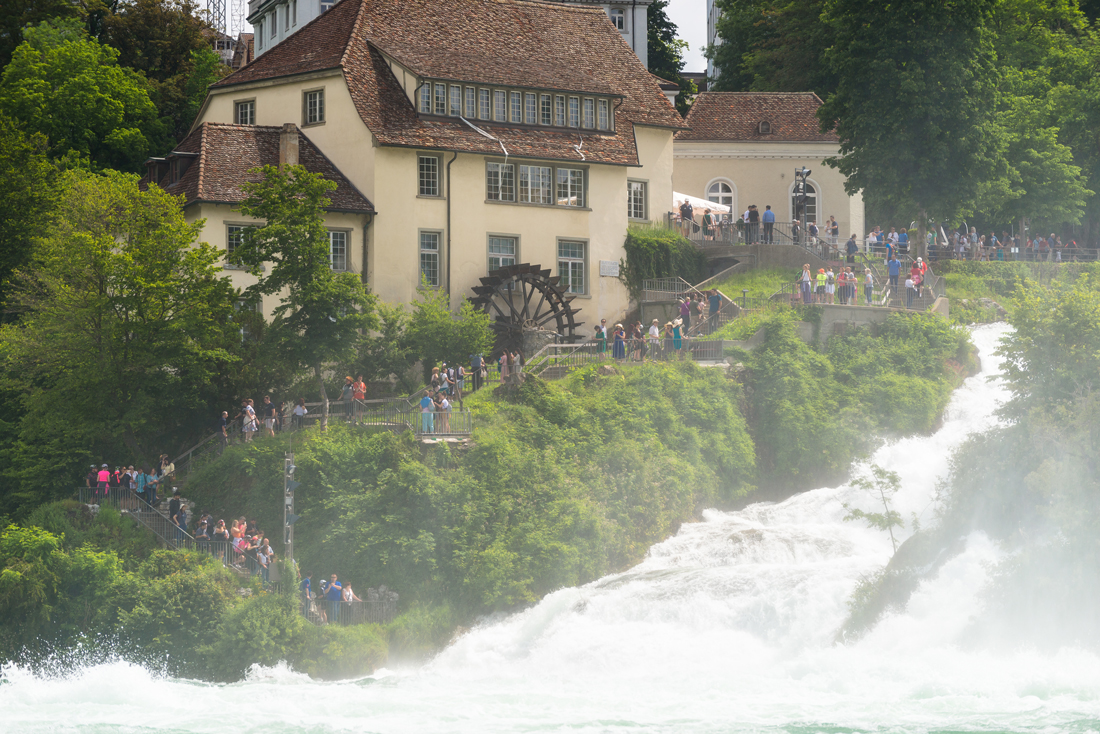
One of the path along the falls. Photo @kinek00 via Twenty20

The central rock. Photo @kinek00 via Twenty20

Schlossi Wörth. Photo @kinek00 via Twenty20

The rocks. Photo @kinek00 via Twenty20
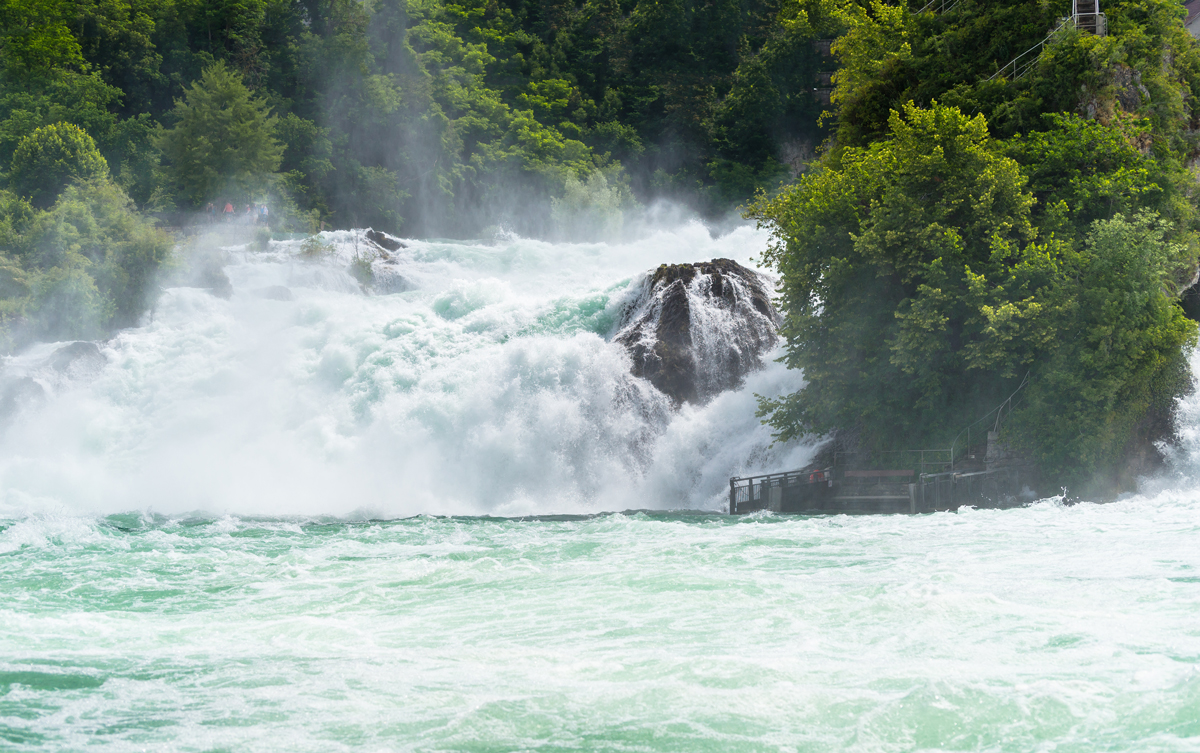
The tumult of the Rhine. Photo @kinek00 via Twenty20
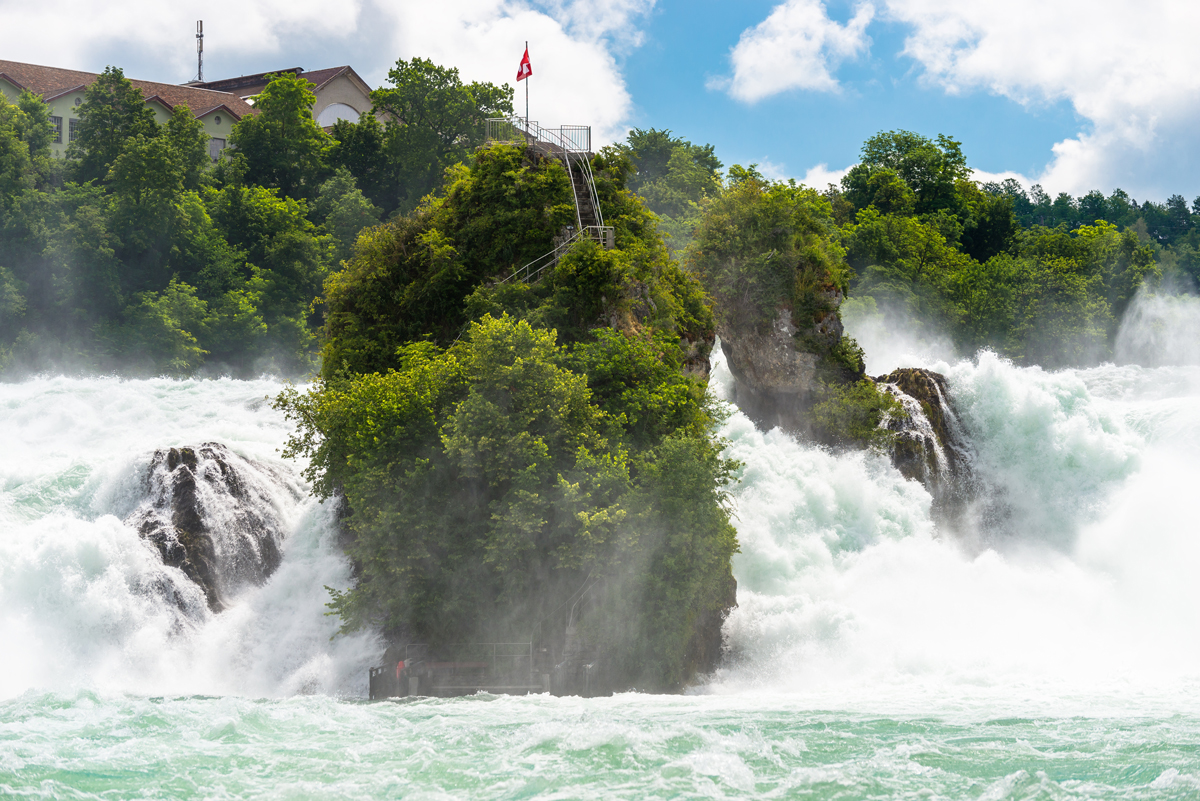
The falls. Photo @kinek00 via Twenty20
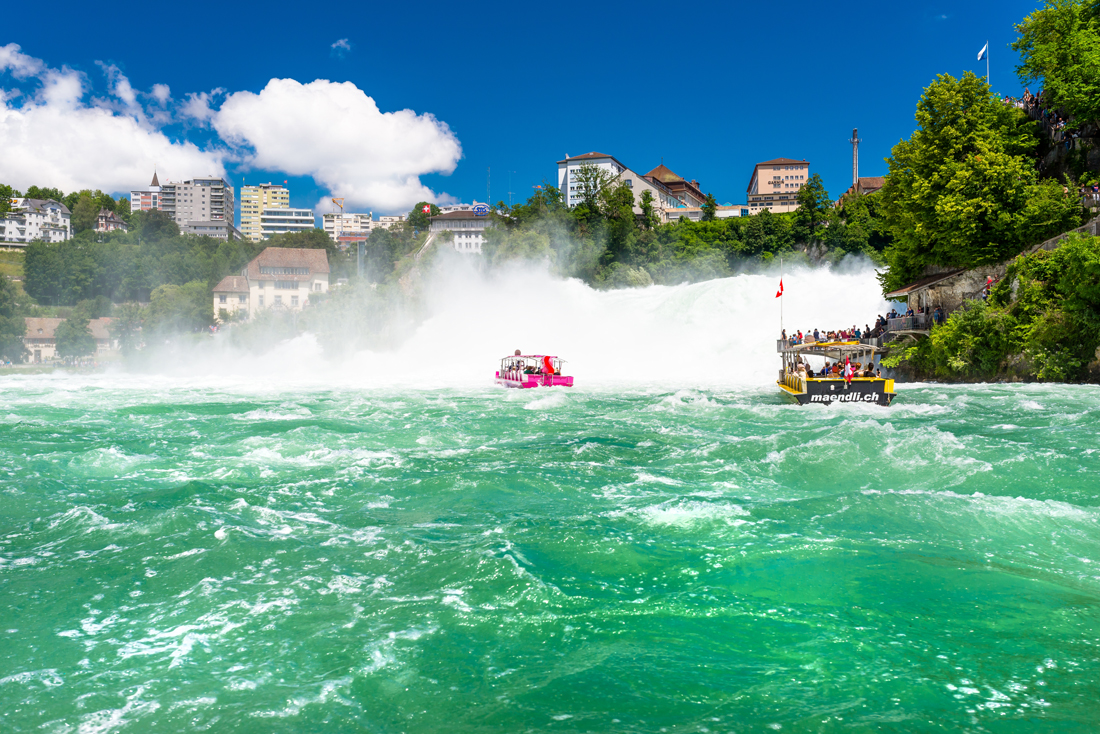
Cruises. Photo @kinek00 via Twenty20
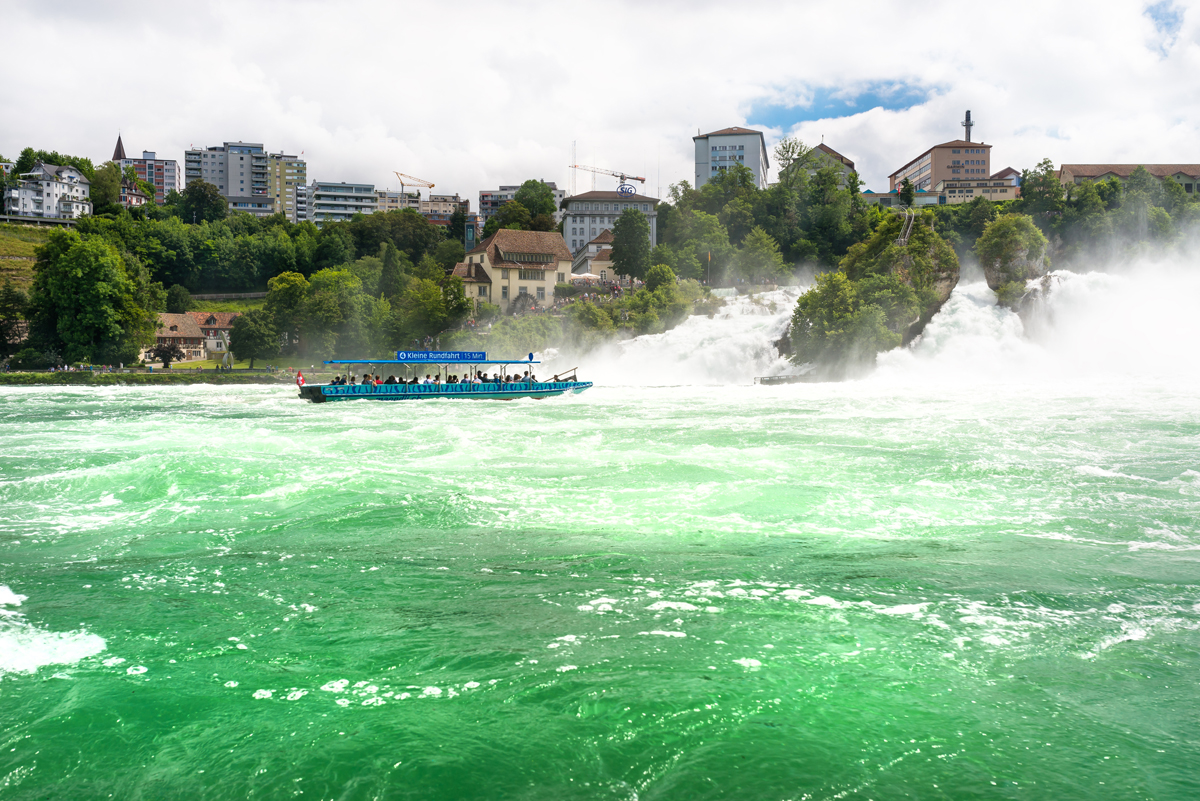
Close to the water. Photo @kinek00 via Twenty20

The Rheinfall little train. Photo @kinek00 via Twenty20
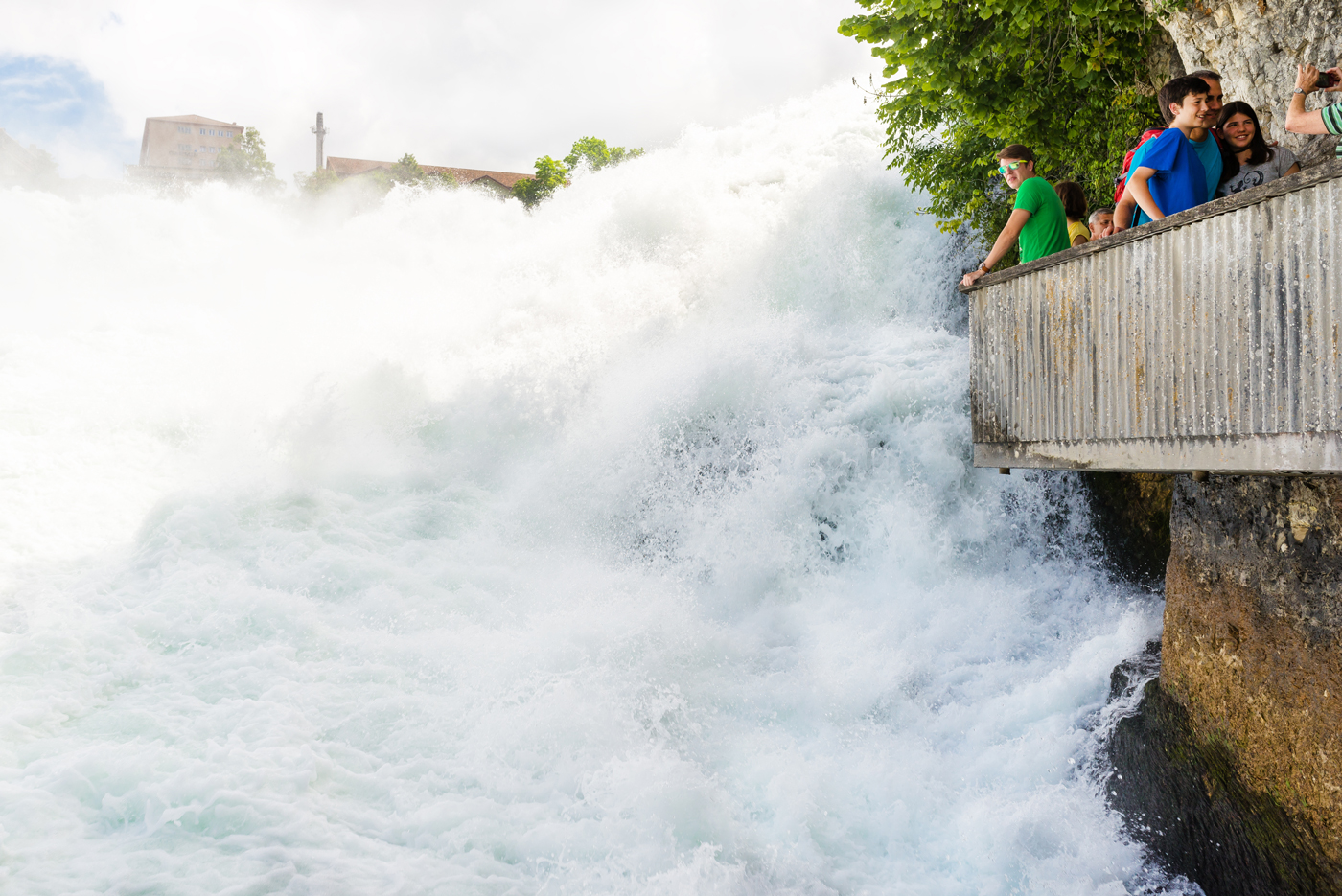
The Rhine Falls observation platform. Photo @kinek00 via Twenty20

Overview of the Rhine falls. Photo @kinek00 via Twenty20
A few pins for Pinterest
Did you enjoy discovering the Rhine Falls in Schaffhausen? Pin the images below on Pinterest or share this article on Facebook or Twitter!
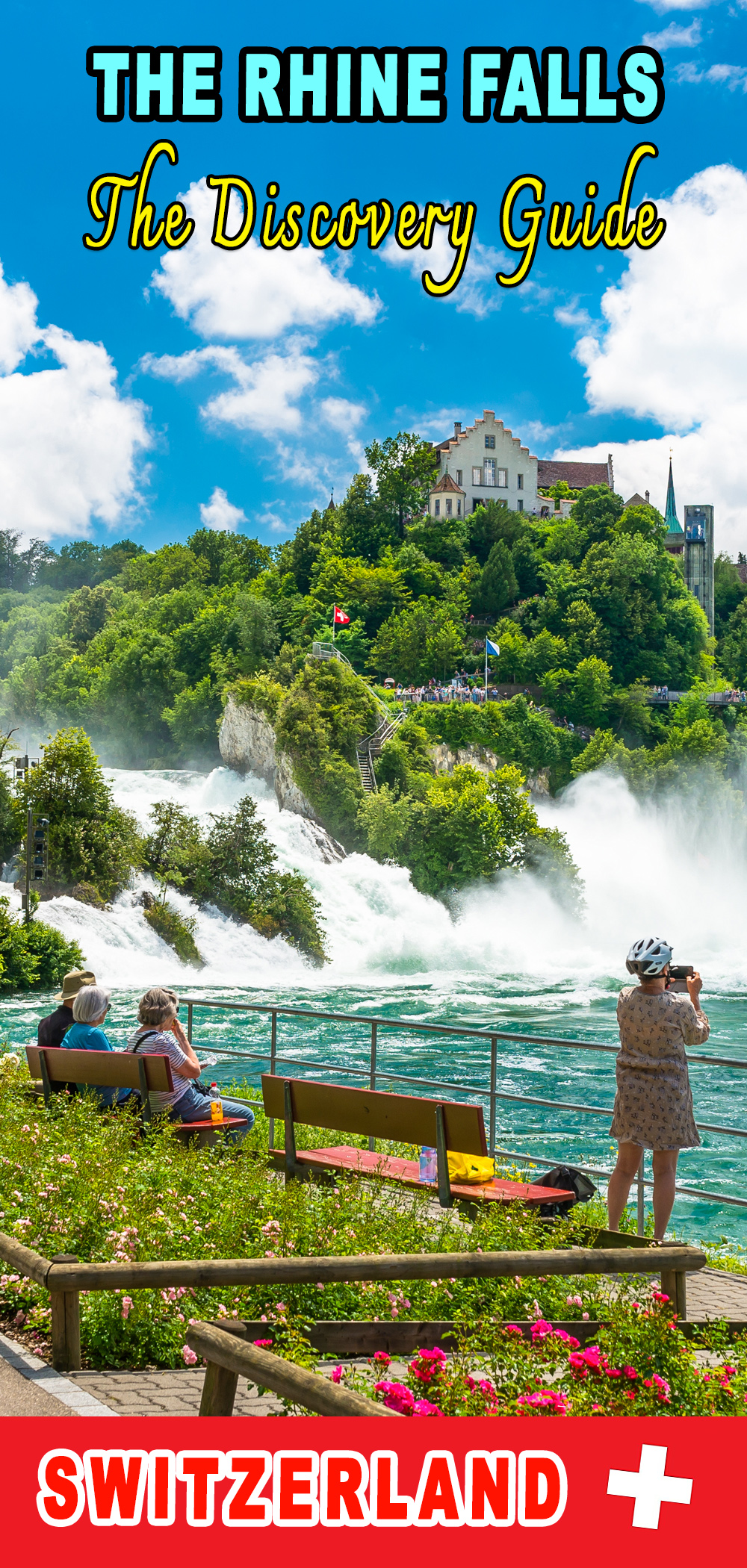

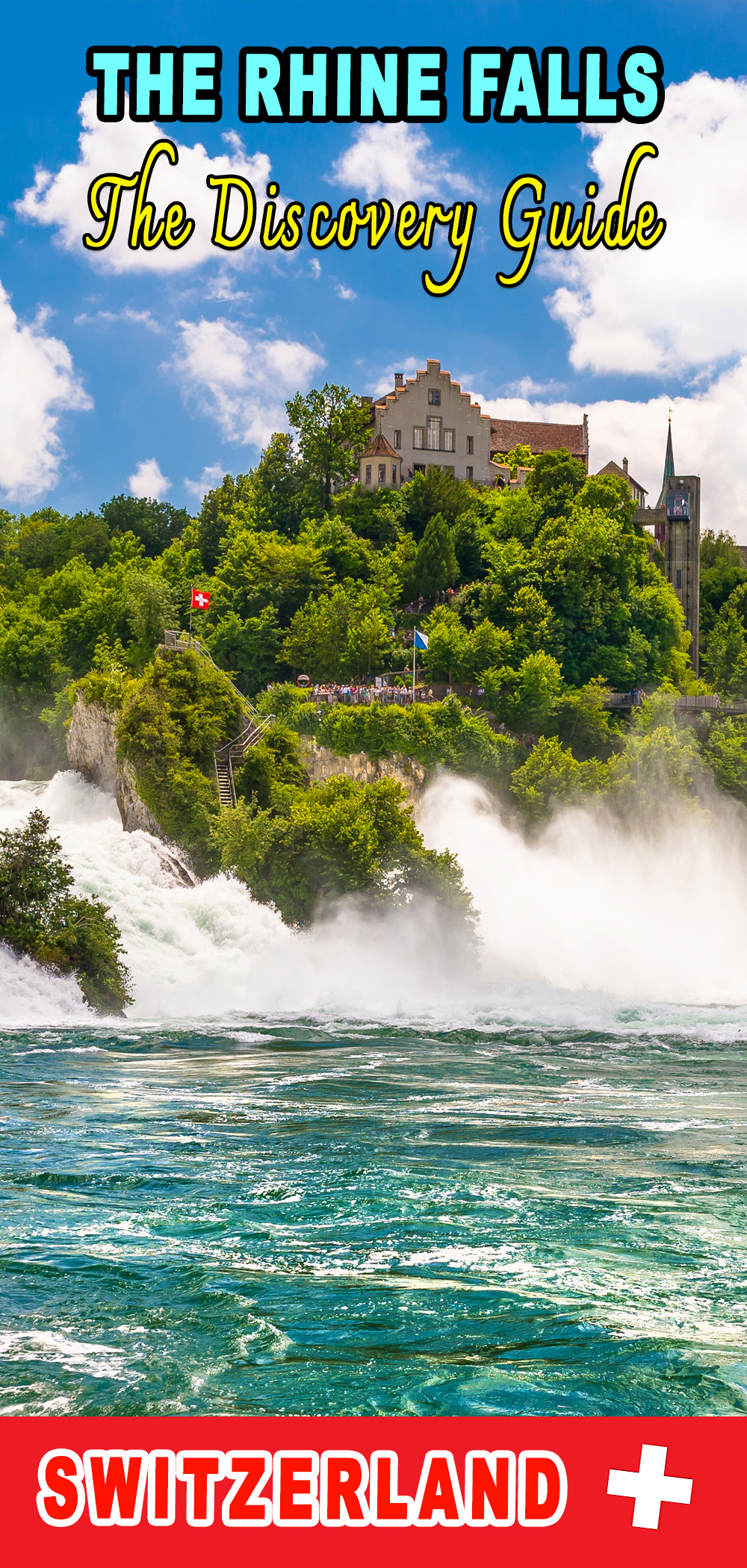

![The Rhine Falls in Switzerland (Rheinfall) © Kabelleger : David Gubler - licence [CC BY-SA 4.0] from Wikimedia Commons](https://frenchmoments.eu/wp-content/uploads/2022/08/Rheinfall-Chutes-du-Rhin-©-Kabelleger-David-Gubler-licence-CC-BY-SA-4.0-from-Wikimedia-Commons-scaled.jpg)


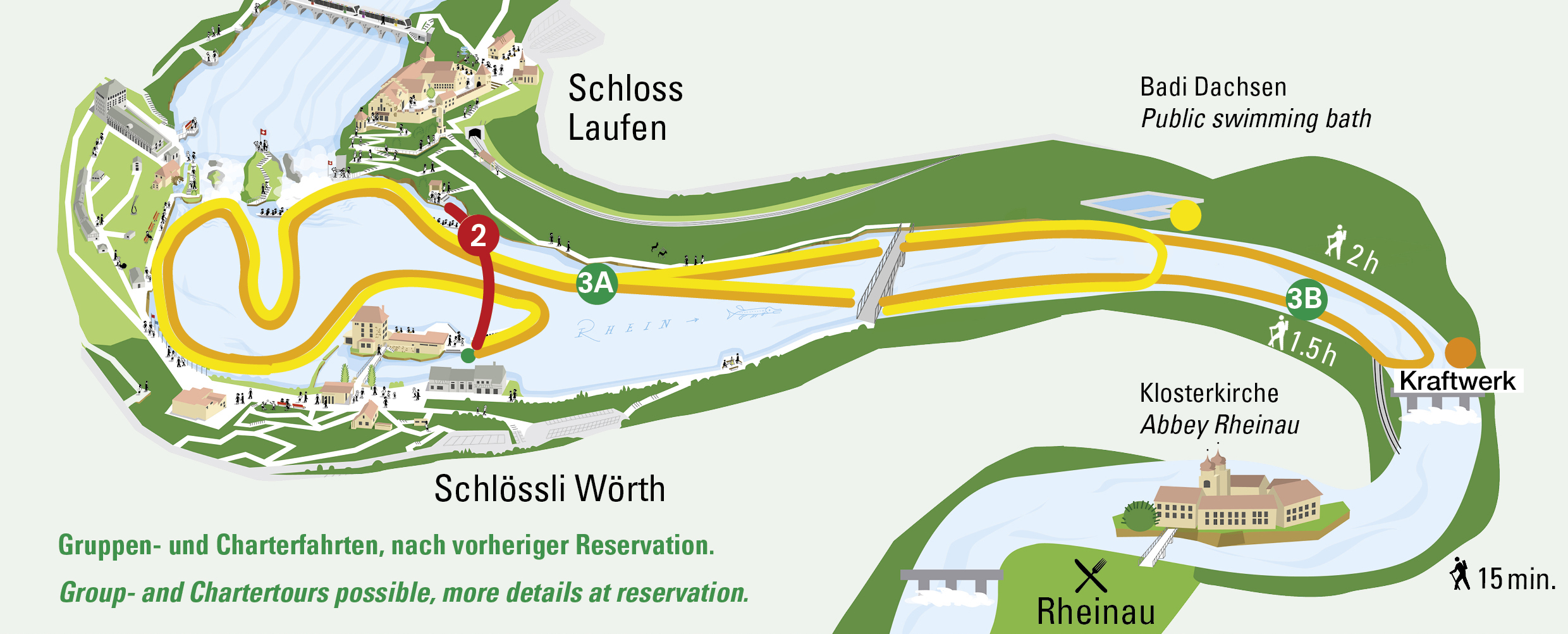


Pierre,
They moved the falls map on you!
From here:
https://www.schlosslaufen.ch/fileadmin/user_upload/schloss-laufen/01_Rheinfall/Rheinfallplan_englisch.pdf
to here:
https://www.schlosslaufen.ch/fileadmin/user_upload/schloss-laufen/01_Rheinfall/Rheinfallplan_en_2023.pdf
Lots of great images on your writeup!
Thank you very much, Bruce. I’ve just updated the post with the new link!